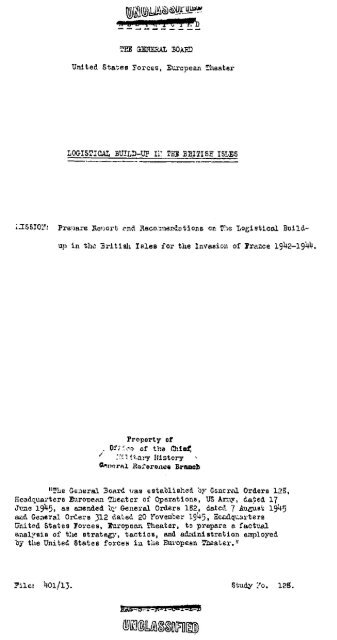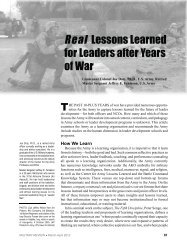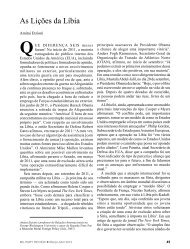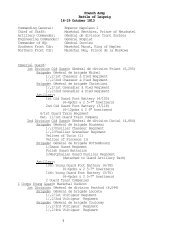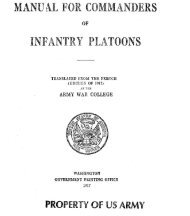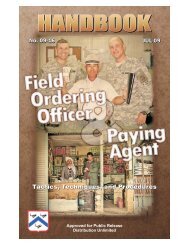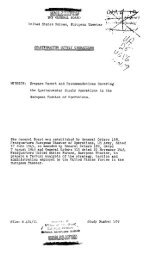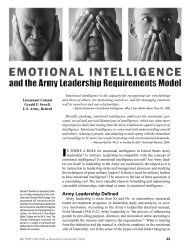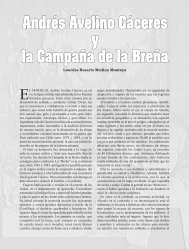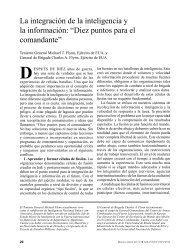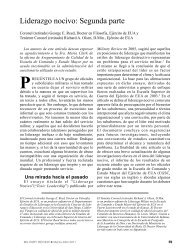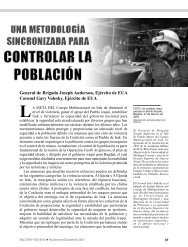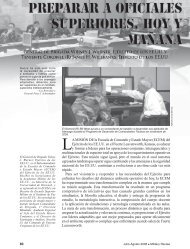ETO, Logistical Build-Up in the British Isles
ETO, Logistical Build-Up in the British Isles
ETO, Logistical Build-Up in the British Isles
Create successful ePaper yourself
Turn your PDF publications into a flip-book with our unique Google optimized e-Paper software.
?'"EE GETlEIwL BOD<br />
bite6 States Forces, Emoueen Theater<br />
"The Ge.2era.l 3mrd tma established by Gsncrnl Orders UE,<br />
fieadquarters Euroae.rr Theater oi G-pcratione, US Am?, Gaf;ed17<br />
Jmc 1345, as mended 'J" General Orders 182, datcd 7 AufisC 1945<br />
a d Geaeral Ortera 312 Aa:ed 20 l'ovenber 1945, Eeaclqxorters<br />
Lir2tc-d States Forces, lhropa,nr, ThcaLer, to prepare a frrctwl<br />
mapsia of <strong>the</strong> strategy, tactics, and adzi<strong>in</strong>istrstion cmploye.3<br />
57 <strong>the</strong> Unite& States forces ia tta Euifopeen Pb.ealsr."<br />
study ?o. 128.
LOGISIICAt m D-UP IN !PBE BRITISU ISLES<br />
Prepmed by:<br />
Major General Royal E. Lord, USA<br />
Lieutenant Colonel Edward M. Polliver, QiC<br />
Capta<strong>in</strong> Irnest A. S~OVA,CAC<br />
Plrst Lieutenant John E. Qitbert, AGD.
1 SCOPE<br />
--____ RES T R I --_-<br />
C T E D<br />
PULE OF CONTKJTS<br />
2. Devclo-pccl; or' URitcd Stp'xs Oiyanimticn ir <strong>the</strong> '4<br />
3ril;ish Ielcs<br />
7. <strong>British</strong> ProcUeJcn;. 15<br />
6. Sp.cial. Sup$ies aad Equioacnt 2cquii-d for ella 18<br />
Operation (Paoco)<br />
9. Shipp<strong>in</strong>g W.it Equipcnt to tho Sritisi: <strong>Isles</strong> 21<br />
1C. Suply of Pcti01eu.i Products 23<br />
11, Documentation ~~-11:liark<strong>in</strong>2 of ~cr11i;sfroa <strong>the</strong> 25<br />
Unit& 5:aLce<br />
12. Zon<strong>in</strong>g of PACBl'iLksh IBles to Feoilitatc SuuTlT 26<br />
De1ivcrT.r<br />
P&S-T=R-I=C-T-E-D<br />
- il -<br />
34<br />
38<br />
2
Tilie :iepir has aa it8 ~ q o s ctile e-a&, 4ii& vex iiiwcrtant <strong>in</strong><br />
<strong>the</strong> developmnt of <strong>the</strong> 3ritM; <strong>Isles</strong> an an iavaslon base .u? Lhc SOS.<br />
Dct.ail5 and hiskorical detn are <strong>in</strong>cluded o~lyto bfie extcnt ncces6e.w<br />
$0 orovi-dc r? bnckgroimd for Chc c~:clusions reached. Suck data hew been<br />
sutriaed largely fi-om lnforAia8:on accxulateb ani studies bcill~,piqared<br />
by thc Ziatoricd Section of Hcrrdounrtei-8. TheatEr Ssrrice Borcef. 3"<br />
!?hs..ater. Thcse studlea ahoul6 -0, ref~rredto fa:- F rllore co?>letc<br />
uiiderstaodi>x of logistical activities lr! <strong>the</strong> Si-ltiah ISLEE.
R*E*S-T-Tc- I-C-T-E4<br />
R-E-S-T-R-I-C-T-E~D<br />
-2-
R-E-S -T-R- I- C- T-E-17
TE2 BRITISH ISLm<br />
3.. Establishmnt md Devclonaert of Phcoter Hs&.r;urters. iIce.dquarters,<br />
United States Aced Forcca <strong>in</strong> <strong>the</strong> <strong>British</strong> Islcs USdFaI 'IRE or mized<br />
<strong>in</strong> Londo:: 0'1 6 Jmuery 19&2. It rmlrrccd tho Sprcial ~ bscrm~ GPOUI) TSPOBS),<br />
1Liicli Laad bccn organizcd <strong>in</strong> iiqv 1941 as part of <strong>the</strong> U;?itcd Statcs %bossy<br />
staff, ad irhioh, unon lihc enbry of tfic Unitcd StRtcs <strong>in</strong>to tllc war had<br />
divorced itself from Ync EU3a60g FSLScconc hc UnitEd Stc.;es military Sedaxartcrs<br />
i:i thc Britisk <strong>Isles</strong>.<br />
E-E-5- T-3-I -C-T-EJ)<br />
- 1%I
R-E -S -T-R- I-C-9-E-D<br />
b. 'Mlc it WBB deeirdole th;t each Genei.e.1 P ~ ZSneciPl Steff Section<br />
have a separate, long-rw.ge. ~ ~ I U and G polic: I ~ ~ group, mc!~officers a6<br />
could be pared for such P scction ceeded <strong>the</strong> co17sl;& cdvice md guidencc of<br />
a11 !cey eat 8peciRliad. oificerr ia <strong>the</strong>ir eztire staff section rxxii %ore tha?<br />
<strong>the</strong>:? needed contact with ulaan<strong>in</strong>; staffs outsidc <strong>the</strong> SOS. '??.is 'ma pnrticu-<br />
1arl:r true of <strong>the</strong> Spcc<strong>in</strong>l Staff Sectiocs.<br />
C. Travel facilities &tween London vn.d chclternm 1°C <strong>in</strong>adEou?.tC<br />
and, for <strong>the</strong> dost pnrt, Cirie-coxu-.i<strong>in</strong>g. 'Fire corr"iceClo3s wcrp elso <strong>in</strong>dequite.<br />
Constant personal 1ia:sos 5etI.wc;l <strong>the</strong> two offices vas igracticrl.<br />
e. Substantiai1:r zow pcrsolliie.1 viae reociree to ogaratc <strong>the</strong> Iii,-dcurtei-s<br />
<strong>in</strong> two cc!ialor?s.<br />
E. Action nabtern werc oltcu &clayed becmse of th frewnt neoessity<br />
of concurreace fro;! both cc:ielons of e. staff secti0.1 .-nd !;>Efranuent<br />
nbscncc of ';>le Ciiief of Section fxox ihe ccllclor, required io teke thk action.<br />
'i'hc <strong>in</strong>term.1 orgenizntion cf SOS (1acI.d<strong>in</strong>g tile Zase Sections), <strong>the</strong><br />
extent Bo vhich it duplice.ted, oi- ."A bU:illccicd by, Ljic shff of &-xdquertcrs<br />
SO, ;:id mproprip.fe C0~c~usi0r.9 md rccommdetiona es to oreaiisatioil<br />
nre':Ue eKnjcct of c scparete stdy and e n "ob ritlii. t>c scope of tbis<br />
docuieat3. It is desirable to ;lo<strong>in</strong>t out here, howvcr, tlmt t~issl<strong>in</strong><strong>in</strong>e.tion<br />
of sepmcte Spcial Staff Sections ox tho llieator erd 50s levels ns Gescri'ued<br />
<strong>in</strong> previous par~-n;~hs, end. Ole ~molntxiif~f <strong>the</strong> Co:i:ie:diTe; Goa-<br />
ereJ, 5CS as G-L, 3uropcar !?he.aa$cr of Operatiox ir 8LaiLiofi- to Lis othar<br />
duties, vere bef<strong>in</strong>ite iqrovemnts ic overall efficieno>--.<br />
5. Conclusiox. Splitti% an SO5 t:rpe Eeedqu~.l'ters <strong>in</strong>fo tvo or ilore<br />
eckslons docrcasbs its efficj.eriq+*to..mchan extcnt e.8 rlnost irraricrbly to<br />
offset axr d~vantn~cs.
R-E-S-T-3-14-T-E-D
(-& -3 1 .n- I-b -x-!i-iJ<br />
and t o use <strong>the</strong> area for $lie acco:.i-,odntioa of <strong>the</strong> nlsjoritg of t3e Uzited<br />
States Forces. These forces, <strong>in</strong> turn, !,ere respoisible for T,rotectii?g<br />
<strong>the</strong> 8.1" a&?.lnbt iiivp,sion e;ld raids.<br />
The Second 30Lm Key Plm, 25 July 15442, vas 'based 02 ar. overall<br />
Wited States build-up for l,lb7,COO, with <strong>the</strong> <strong>in</strong>vasion datc rena<strong>in</strong>iili;<br />
uchangod. It gave fur<strong>the</strong>r details In lire vith <strong>the</strong> basic decisions<br />
of tie first Plan. Included <strong>in</strong> it tiex provisions for receiv<strong>in</strong>g 120<br />
stii~1oeLsper zoiith of supj1lics fox Urited States Foreas, om-fourth<br />
of v1iicl.i vas estiiated to be vehicles end tiio-t!d&s of vlcich ''rere es-<br />
Wanted to require coverea storqc. To hondls ti;fSToR??5t t& ports,<br />
<strong>the</strong> United States 1698 to supj1e:ient <strong>British</strong> dock labor r.itfi sixteen<br />
port Wtnliorrs c d eight servicc battaliom, It m e anticipnted t-ht<br />
<strong>the</strong> 3ritisli rail systc; vould have tu provide 300 passenger end ba;:~age<br />
tra<strong>in</strong>s per ~.1oilthand sixty frei&t trails per dey.<br />
POOLIlrG OF BXXSH - A.ZSIC& LOGISTIC& F3SCL;RCES
R-E-S- T-R- I-C- T-ErD<br />
IiI R co:qn~ol:lise, <strong>the</strong> Transportrtion Corps contwlled all zovexeents<br />
b;l those ~X'BRS of tiic EritisL <strong>Isles</strong> Irliero United Statcs iorczs were <strong>the</strong><br />
8o::iimr.f uscrs. <strong>British</strong> personnel i.rerc assismed os aa3ord<strong>in</strong>r.tr.s i: such<br />
meas, with UriLed States persor?llel Uci:ig asaiged as sxbord<strong>in</strong>etcs ii?<br />
PTC.-.G 4icre <strong>the</strong> Sritish were tllc pr<strong>in</strong>cipal users,<br />
a. Tiic foll.o-4>
II;E-S-I-F.-I-C-T-LD<br />
- 10 -
R-E-$-T-R- I-CT-E-D
RrZ4-T-R- I-GT-E-D<br />
- 13 -
21. _Gonclusione.<br />
R-E-S-T-R- 1-C-T-n-D
R-E-S-7'-R- X-C-T-E-D<br />
22. Procurenmt Oiijectisas. Initizl ?lam ti?. cot sisunli~eextcilai~eproourenent<br />
of supdics <strong>in</strong> tlie 3ritish <strong>Isles</strong>. '?:;is orlnclple<br />
was sjecifically ststed <strong>in</strong> :'o-fe:.iUiurr 1941 by <strong>the</strong> j0ii:C Any ami ?:flT<br />
&sic war plans RS follows: "Tile United States forces sil.1, e.5 fe.r c?s<br />
pxcticablc, drew <strong>the</strong>ir logititice1 supnozt (eujmly ~xdr.eicte;lAi:ce) fron<br />
sources outsiAe tile 3ritid: <strong>Isles</strong>. SubJect 20 this nr<strong>in</strong>ciple, hotfever,<br />
<strong>the</strong> >ilitary bfisis, rq?air facilities end sugpliea of ei<strong>the</strong>r nation l.dll<br />
be nt <strong>the</strong> dimosal of tie :lilitprF forces of <strong>the</strong> o<strong>the</strong>r as rcouired f or<br />
tlic successful prosecutior. of t 'e xserlll, ~ius,<strong>in</strong> sett<strong>in</strong>g up tlie penera1<br />
Purclmsiag 30ext. <strong>in</strong> <strong>the</strong> 9ril;ieh <strong>Isles</strong> it *!as Colt t,ii&tIts fwictioiis<br />
nould Consist pr<strong>in</strong>clpdly of tila<strong>in</strong><strong>in</strong>2 2nd prepareti028 for procdreient<br />
on tile contiaent,2<br />
This iritial plcn of li:.iitsd p-ocure:.id, :::<strong>the</strong> Sritish <strong>Isles</strong><br />
?res changed <strong>in</strong> t~€Bwxier of 1942 for t?m basic reas03s:
R-E-S-T-R-1-C -T-E-D<br />
d. Duriix tlia pariod iro3 1 J we l9b2 to 30 June l9iL', 315 of<br />
all United Ste.tes supplics <strong>in</strong> <strong>the</strong> 3uropp.m Theater cme fro.:. aritish<br />
BourcBs. Of <strong>the</strong> total United Stotea Arw tonnage aesenblecl ir 2.e 3rltish<br />
<strong>Isles</strong> Sp D-Day, 39'; had been procured fron tix 3ritlah.<br />
ConsiLerabla difficultjr VAS experienced <strong>in</strong> hadl<strong>in</strong>g, stor<strong>in</strong>g,<br />
Aild effecblva1;J uti1isi::G certa<strong>in</strong> Sritidi3rocured supplies becouse of<br />
tkbtr dissiailar xrl:kqs ?r?3 iiifcrior pfickag<strong>in</strong>g strzdards. ;ia?~of <strong>the</strong><br />
coztairera hed to 5e re<strong>in</strong>forced by Uuited StAtes dc?ots before ~h<strong>in</strong>i~~fi<br />
oould :,e iide t o Mricn <strong>in</strong> 1942 and 1913. 3y <strong>the</strong> tise tlie <strong>in</strong>vasion <strong>in</strong>to<br />
Franco vas .rounl;ad ii: 194.4, considarable iqrovexn!; had bee: imde; however,<br />
thc *.raste or' Sritish suy~liasbecause of differeiib md <strong>in</strong>ferior<br />
gackagi;lt; as& :mrki.X was sti1.l qite mixtantiel.<br />
zG. Goncluaiona.<br />
e. Corrplcxities of foreiQi procurexnl; or. n lnrge scde are<br />
SUC:I L<strong>in</strong>t control s!io\;lG. >c vested iu R strong, cer.kral ?;occi-eucxb<br />
q;cncy fuctionixl; on tl!e 0oacre.l or Special Staff level of Ei<strong>the</strong>r SOS<br />
or Tliac.l;er Eandquarters, Ha egpropPiate. Tie desira5ilif;r of en& an<br />
agency Ius beer. prove3 <strong>in</strong> 30th Varlc? Vars I md I!.<br />
3. Yoreign procurelect of mqplfes and muipxn'; for use unCer<br />
operational conditions tcuds to 'se unsatief~ctor;-for F. large percentage<br />
of itma becmae of <strong>in</strong>ferior and dlssi!dlar qulity, pRckc&w-, narkixa,<br />
uoertr<strong>in</strong>tiea of scheduled deliveries, ant bifflcnlties of repair<strong>in</strong>i; and<br />
:m<strong>in</strong>tahlag <strong>the</strong> ecd 1ter.b.<br />
C. !$hap. large .foreign orocurement progr'sma ard db8i'Fdole<br />
tn oom'cction ri:h active Operation6, cOUeful consideration<br />
should 'UE &vci: to <strong>the</strong> ac\visn>ility of i)rovicli~ suitable pckiw<br />
end :.ilarki,q SU-JQ~~CB ziud EqUipileIt fuon lillited Stntcs swrcea, 01- of<br />
IzcluiiW such item <strong>in</strong> tho ;irocm:llent nrograi~OB a spci,il project.<br />
b. Predeterniimtian of A i~ethodof evaluation .?:ad pric<strong>in</strong>g is<br />
esseaticrl 'uaforc e. forbig: p-ocure:.mnt prot;ra-i is ixitiated. If tllis is<br />
not Gone, differences \rill Frise ~Ciich,aside fro1 zoiietary conaideratiws,<br />
vi11 result <strong>in</strong> unfortunate disclgreerleUt6 ad ill-feelhg even on<br />
<strong>the</strong> hidest levels. Thet such results did not occur to q.'aerious extant<br />
ia <strong>the</strong> 3ritish IE~EG<br />
*+as a tri'nats to <strong>British</strong> <strong>in</strong>tegrity ai?.close<br />
3ritis:i-A-icrice.n cooperatlor.;;,<br />
R-E-S-T-LI -C-T-C-D<br />
- 17 -
BESTBICPED<br />
SCl’ION 8<br />
SPplCIdL SUPPLIBS &I9 EQUIPHEITI! mREn<br />
FOR TIC& OPERATIOZT (PROCO)<br />
27. Background. Dur<strong>in</strong>g 1942 and early 1$3, all Items required<br />
to Wet mjor operational needs rwere rpecified first by COSSAC knd<br />
later by G-b of Eeadquartors, <strong>ETO</strong>, Their eqerlenco 13 atteqt<strong>in</strong>p to<br />
compile a complete list of items, and Lhe defioi- br-t to<br />
light by <strong>the</strong> mount<strong>in</strong>g of a portion of <strong>the</strong> African nyeration iron <strong>the</strong><br />
Sritish <strong>Isles</strong> led to <strong>the</strong> conclusion that only <strong>the</strong> Special Staff Sections<br />
Of 505 ~oaaesssd adequate technical an2 detailed hnovledge to calculate ,<br />
coaj-jlete requirements.<br />
28. Baais of CRLculaEions. Theiefore <strong>in</strong> June 1943, -hen <strong>the</strong> “ar<br />
Department direcked <strong>the</strong> European Theater to 6Ubmit requirements far<br />
major Class IV items end for Class I1 Items above T/U mG T/E for <strong>the</strong><br />
rema<strong>in</strong>der of 1943 and 19N1, it was decided to &e evaila3le to <strong>the</strong><br />
50s Supply Serrices &e.eouate taotical and logistical <strong>in</strong>fomation to pcrnit<br />
<strong>the</strong>m to calculate <strong>the</strong>ir own requlremsnts. Separate reaidrements<br />
for U~OOJIUIIOII items were to he submitted ’by thk &tr Force.<br />
The tactical and logidtical basis for nalculat<strong>in</strong>g thse reoulrsments,<br />
based partly on asmmtions and partly on <strong>in</strong>formation availabls<br />
from EWOPRIU Theater Headqusrters. and COSSAC, was published 02<br />
24. June 1gL’ by Hadquarters 505, <strong>in</strong> a concise seven-pege doauPciht vhlch<br />
CW~Eto be one of <strong>the</strong> more important factors <strong>in</strong> plac<strong>in</strong>g logisticel plann<strong>in</strong>g<br />
Rnz preparetions on e. firm b8sls2. htndmental facts conta<strong>in</strong>ed <strong>in</strong><br />
<strong>the</strong> document vcre suhjitted to end aqproved by tlie Ynr Department ths<br />
provid<strong>in</strong>g a con!” basis for submitt<strong>in</strong>g and sdlt<strong>in</strong>g requlrementsf.<br />
It i s worthy to aota that this document <strong>in</strong>cluded wimt prqved<br />
to be, with one or two exceptions, <strong>the</strong> m<strong>in</strong>im acceptable <strong>in</strong>formation<br />
upon vhl& <strong>in</strong>telligenot, long-range plann<strong>in</strong>g could be basad. It <strong>in</strong>cluded:<br />
a. Troop basis by mjor 1;Wes of units, e&., divisions,<br />
classified as Infantry, Aruored and Airborne.<br />
b. Rate of t.roop build-up on <strong>the</strong> Contlnont e.nd rato of troop<br />
iaflou: to <strong>the</strong> United xiqdom.<br />
c. b?urabcr and characteriatica of L<strong>in</strong>es of Comuicotions, <strong>in</strong>alad<strong>in</strong>g<br />
an eStimft6 of tho notor transport requireaents.<br />
8. .Jumber of major and m<strong>in</strong>or poth to be rehabilitated.<br />
e. Estimate of nirfield oonstruction recuirod and munber of<br />
plazles t0 be supported on <strong>the</strong> Cont<strong>in</strong>ent for <strong>the</strong> first three months.<br />
f. hthoriaed levels of Supply on ths DohtInent.<br />
g. EstimatB of enemy dfDOlitiOn of porta, bridges, rail equip-<br />
ment, and signal communications, expresaad In percentages.
RESTRICTED<br />
It was found poselble to fuipish <strong>the</strong> above Information <strong>in</strong> general<br />
terms without divulg<strong>in</strong>g <strong>the</strong> spccific geographical locntion or <strong>the</strong><br />
qeciflc date of <strong>the</strong> operation.<br />
The document omitted irfonation and asau$ptions on two factors<br />
which later proved to be of consideraole iqorbce:<br />
a. Xn evaluatio2 of necessary swly responaibllities for<br />
<strong>the</strong> civilian population. Zhis omission nay have been <strong>in</strong>evitable, as<br />
determimtion rf such rebponsibillty ma not forthcom<strong>in</strong>g from higher<br />
levels until a much lehr &ate.<br />
b. Bn evaluation of tho eupply implications of mount<strong>in</strong>g tki<br />
opcration fron <strong>the</strong> <strong>British</strong> <strong>Isles</strong>.<br />
Dur<strong>in</strong>g July end August 19&3,<strong>the</strong> coaptation of specie1 re-<br />
quiments wce complotcd by Supoly Services <strong>in</strong> <strong>the</strong> fon of projects, each<br />
limited to a spcciflc Item or eroup of items and each conta<strong>in</strong><strong>in</strong>g c coilplete<br />
justiflcntloa. Eeyirenents fo? likc items were consoliGated by<br />
<strong>the</strong> Service hav<strong>in</strong>g promemcnt reponoibllity <strong>in</strong> <strong>the</strong> United Statc6.<br />
Thesc projects, a6 supplemented end mended from time to time, f0rmCd<br />
<strong>the</strong> besls for all special supply requirements for <strong>the</strong> entire operation.<br />
They were referred to as flPROC0 Projeots", both <strong>in</strong> <strong>the</strong> Suropean Theater<br />
cnd <strong>in</strong> thc UnPtod States.<br />
3. &e of Surcial projects. %hare developed a signifloant diff0IEnCe<br />
h Ou<strong>in</strong>ion betrtcen <strong>the</strong> War Dmartment and <strong>the</strong> Eurorwan Theater<br />
e6 to tile pripcr scope cf thsse Iong-iange eatime.tes.<br />
The SOS, Europeen "heater h d prepared prcjeots on <strong>the</strong> ~ssmption<br />
that thcy should Include all Itens of supuly for iqhlch <strong>the</strong> estiua-<br />
ted necd would be aubatmtially greater than <strong>the</strong> nornal coubet u-s<br />
factors. The Suropean l'beater realized th@tcombat factors, thc ocels<br />
On which <strong>the</strong> 'Iar Departnent was est<strong>in</strong>atiry procurement, did not t&e<br />
<strong>in</strong>to considcration csrtdn peculiarities of thc cantaplated operation<br />
<strong>in</strong> kropo such es ship-s<strong>in</strong>k<strong>in</strong>ce between <strong>the</strong> Sritish <strong>Isles</strong> and France.<br />
Therefore, chc <strong>in</strong>itial projccts submitted bjr <strong>the</strong> SOS, Eurqeen Theater<br />
<strong>in</strong> July and August1943 h d Included nsny cormon items (c.g., rations)<br />
as vel1 88 special items md snjor equipment.<br />
E%?Ver Dcpartnent, on <strong>the</strong> o<strong>the</strong>r hand, had iatendcd <strong>the</strong>ir dirrective<br />
to cdL for spccid requirements of ncjor itms only, and <strong>in</strong><br />
Septmbor 1943 it propoeeZ. tllat dl projects co-Jeer<strong>in</strong>g excess issue of<br />
nomil itcma be rithdrarm by <strong>the</strong> European Thcater and subnlttcd by<br />
normal rcquisitim<strong>in</strong>g procedure. 4<br />
There followcd an exfitCqeof cnbles <strong>in</strong> wkich <strong>the</strong> 'Yar DepmL<br />
mcnt agreed thRt projects alrerrdjr gubrdtted would 'sc processed, but<br />
epecified that additioznl projects would not <strong>in</strong>clude excess roouireacnte<br />
of common iterns.5<br />
However, <strong>in</strong> Ootobor 1943, <strong>the</strong> Var Departnent recoueldercd its<br />
previous daclsions and t-pproved <strong>the</strong> we of PROCO projects for all rcquiremcnts,<br />
<strong>in</strong>clud<strong>in</strong>g comon items, <strong>in</strong> xcess of nomal supply as had<br />
beenlnitially recamended by 50s. Z"O.& This deolejon permitted thc<br />
immediate editihg and prochasa<strong>in</strong>p, of <strong>the</strong> projects by tho Zone of Interior<br />
4.<br />
5.<br />
6.
BE S T 9 1 C TED<br />
zml established <strong>the</strong> s<strong>in</strong>la aid logical basis that all operational rcquireuuts<br />
In excess of norid, <strong>in</strong>itid issue FAc0mbe.t fe.ctors ctculd<br />
.E sub~itted <strong>in</strong> thc fon of special projects. It dso fomed tho basis<br />
which, conb<strong>in</strong>mi wit'? dist<strong>in</strong>ctive mrklags, facilitated <strong>the</strong> easy segreention<br />
e& proper issue of special supplies, especially paclcchged sup-<br />
~ l i ~ <strong>in</strong> s , tho Europcm Theater.<br />
33. Requirements Followi.lp Initial Projects. Subsequently, dirkotF-"-es<br />
'rere issued by SOS, ET0 call<strong>in</strong>g for thc subaission of projects<br />
for 1911.5. Flexibility end re.pid proaess<strong>in</strong>g was aided 57 <strong>the</strong> "er Depwtncnt's<br />
dclogat<strong>in</strong>g of mtlrority to tho New York Port to approvc dccreeses<br />
an& reasonablc <strong>in</strong>creases to pmjecte hav<strong>in</strong>g VPX Dspertoent approval <strong>in</strong><br />
yr<strong>in</strong>ciplc. Thc entirc nroccdure for editiag, process<strong>in</strong>g c.nd so forth of<br />
PB@CO projects wao euilimFizcd <strong>in</strong> a direotivc pub1ie:icd by <strong>the</strong> New York<br />
Port <strong>in</strong> Novcnber 19437.<br />
31. Considcration of Britisli Procurcaent. No deductions were' nade<br />
fron P-wc@projects for SU3plicS t o be urOOWod fron 3ritish rescurcea.<br />
Estirxted quentities tlim&& to be procurable nerei <strong>in</strong>dioatEd <strong>in</strong> th projcct<br />
md lntcr cancelled Y9ien dcllveries fron <strong>the</strong> <strong>British</strong> wre dcf<strong>in</strong>itcly<br />
aseurcd. Tills proved to be a desirable precaution ns <strong>British</strong> ebility<br />
to produce YP.~, <strong>in</strong> certairr <strong>in</strong>stnnces, affected by bonb<strong>in</strong>gs md o<strong>the</strong>r<br />
ud orcseeable circwstrooe6.<br />
32. Daficicncies of PEOCO Projects. Perhaps tihe aost serious deficimc?<br />
i.?rcquirsmciits 86 subnittad Uirough P-%cO projects was that<br />
<strong>the</strong>y did not roflect dur<strong>in</strong>g 1943 <strong>the</strong> specific dcsires of major fieid<br />
comiande scherhled to t&e ?art <strong>in</strong> <strong>the</strong> <strong>in</strong>vasion, especially dur<strong>in</strong>g Its<br />
6arly oteges. This was <strong>in</strong>evitable because those oomnds vera not available<br />
<strong>in</strong> <strong>the</strong> Europe- Thecter until <strong>the</strong> end of 1943.<br />
Theoreticnlly, requirenenta wtmibted by <strong>the</strong> Supply Service6<br />
covered requirements of those co.wnds. Actually sliortages dib occur,<br />
pr<strong>in</strong>cipally for two reaions: first;, 6uply Ser-vlces could not In ell<br />
<strong>in</strong>sfences anticipate <strong>the</strong> detpile of <strong>the</strong> tactical plus to <strong>the</strong> extent<br />
that <strong>the</strong> Arq Headquarters <strong>in</strong>volved could: and secondly, Army comenders,<br />
given oonsiderdole leevrkv <strong>in</strong> implement<strong>in</strong>g Oacticd plane, hed <strong>in</strong>dividual<br />
aethods of operfitiiig whl& resulted lr. special reauirements.<br />
a. Ifithhold<strong>in</strong>g supplies until us<strong>in</strong>g units were <strong>in</strong> operation cn<br />
<strong>the</strong> Cont<strong>in</strong>ent.<br />
b. Issu<strong>in</strong>g supqlies <strong>in</strong> <strong>the</strong> <strong>British</strong> <strong>Isles</strong> to <strong>the</strong> specific organizations<br />
that had <strong>in</strong>itiated projeots, only as supplies shiPPed under<br />
<strong>the</strong>ir project number arrived.<br />
c. Plac<strong>in</strong>g td,1 P"20 ~u~mlies <strong>in</strong> a comon pool to be issued on<br />
established priorities to organizations hav<strong>in</strong>g approved project 6, re-<br />
E-?l'Kless of whe<strong>the</strong>r <strong>the</strong>ir specific euwlies hcd errlved.<br />
7-%? Section, Bew Yo& Port of Embarkation, "Stand<strong>in</strong>g Operet<strong>in</strong>g pl'ocedure<br />
I4e"andum 1To. 711, 15 Xovember 1945.<br />
R-E-s-~-E-I-C-T-EJ<br />
-20-
RESTRICTED<br />
The last method was decided updn end <strong>the</strong> 7ariOUE major commands<br />
and organizations were given a creciit and e priority on <strong>the</strong> central pool<br />
to %he estent of prcjec'ts sui~mitted'OF Llem or nroject EUPglieS ellocated<br />
to <strong>the</strong>m. This urocedure elso Droved Cesirable becauae eoepnent that lies<br />
issued <strong>in</strong> <strong>the</strong> Sritish <strong>Isles</strong> could be checked for pornpletenese and workability<br />
by us<strong>in</strong>g units before <strong>the</strong>y deoarted for <strong>the</strong> Cont<strong>in</strong>ent.<br />
34. Conclusions.<br />
8. Division of responaibilifiee between a 3ectster of Operr.tions<br />
and <strong>the</strong> !!ar Deprtment for ask<strong>in</strong>g basic estimntes for loa~range procuvement<br />
or production should be clearly def<strong>in</strong>ed. ?hi6 responsibility<br />
should normally be placed on <strong>the</strong> Theater es soon AS its staff I s sufficiently<br />
organ<strong>in</strong>ad, <strong>the</strong> VN' Department reta<strong>in</strong><strong>in</strong>g <strong>the</strong> regorsibility for<br />
eveLuatlng <strong>the</strong> requirements to <strong>in</strong>sure aga<strong>in</strong>st both onissions end excessive<br />
requiresents.<br />
b. Supply equipment reauirements should al:iays be cdcdntcd<br />
on <strong>the</strong> Special Staff level. Efforts to celculete long-range requirements<br />
on D Gsnersl 5teff level result <strong>in</strong> importent omissions be-<br />
ce.use of <strong>the</strong> large numbfir of itsss <strong>in</strong>volt-ed and <strong>the</strong> detniled technical<br />
kilotfledge required.<br />
C. In long-range euFply forecasts it i s necessary to <strong>in</strong>clude<br />
-11 ItComQon it8mE" os tiell as major br.its of aquipoent. Difficulties<br />
Of <strong>in</strong>creas<strong>in</strong>g production of 1'comon item" (e.g. cmned vegetables,<br />
properlr peckaged) often cause those items to require as much t<strong>in</strong>e for<br />
production as do ne,jor item of eouipment.<br />
d. To <strong>in</strong>sure rrlequate supDly, tacticd plnna ea well -8 89<br />
evaluetion of <strong>the</strong> sitwtion to be encauntered mst b6 sade nvailable to<br />
both Genera and Special SteSf Sections on <strong>the</strong> Theater cnd SOS:levePB,<br />
as rapidly e.6 thssr are c?eveloTed <strong>in</strong> tentative fam.<br />
a. The submission of supply requirenent, <strong>in</strong> excess of noimal<br />
rates, T/Ets :nd T/9Als shmld be <strong>in</strong> <strong>the</strong> form of special. nwhred projects.<br />
Requirements for common items should 'de coneolddated by <strong>the</strong> pro-<br />
cur<strong>in</strong>g service. Thiu prooe&,ire ha5 proven highly auccensful <strong>in</strong> melnta<strong>in</strong><strong>in</strong>g<br />
A clear picture of thr SII>J>ly status, and ?)hen ca.b<strong>in</strong>ed rith specid<br />
mark<strong>in</strong>gs, <strong>in</strong> provid<strong>in</strong>g a simple meane of controll<strong>in</strong>g storege segragation<br />
and issue.<br />
f. Supply plann<strong>in</strong>g nuat; <strong>in</strong>clude I<strong>the</strong> rk.limtion that army COIFmnnders<br />
under combat conditions mat be given suplias ud equipment <strong>in</strong><br />
bhfltever qupmtities <strong>the</strong>y desire with<strong>in</strong> <strong>the</strong> resources of <strong>the</strong> Commnicatlons<br />
Zone. Methods of operation Teouliar to <strong>in</strong>di;ridd e m com9ndei.6 require<br />
<strong>the</strong> use of different item of supply md equipment to very<strong>in</strong>g cxtents.<br />
Tnerefore, vhencver army comr.ders and <strong>the</strong>ir staffs ere avsilable,<br />
<strong>the</strong>y should be csreful1;y consultcd on long-rea4e S<strong>Up</strong>plY and equipment<br />
plnnn<strong>in</strong>g.<br />
SECT1033 2<br />
SHIPPING UI?IIc EQIJIPbmT ID 'i" 3RIPIsh' I s<br />
35. The Problem wp.8 to et T/E equipsent <strong>in</strong>to <strong>the</strong> :"le Of unite<br />
ee soon after thoir ariiv&t <strong>in</strong> <strong>the</strong> <strong>British</strong> <strong>Isles</strong> e6 possible <strong>in</strong> order<br />
to enable <strong>the</strong>m to become &m<strong>in</strong>istratively self-support<strong>in</strong>g>rrdd t o rcm<br />
e thcir tra<strong>in</strong><strong>in</strong>g, or, <strong>in</strong> <strong>the</strong> cane of service ~niLs,<strong>the</strong>ir functions.<br />
hftl bier 1945, BI attempt I~EB d e to Accomplish this by hav<strong>in</strong>g units<br />
cret8 tlieir o,.,n equipment md rtforce markfl it 'oef0i.e <strong>the</strong>y left <strong>the</strong> United<br />
R-E-E-T- R-I -C-T-E-D<br />
- 21 -
R B S T R I C T E D<br />
States. The plan assume& that shipp<strong>in</strong>g <strong>the</strong> equipment at or before' <strong>the</strong><br />
departure of <strong>the</strong> unit rrould get it to <strong>the</strong> Sritisli <strong>Isles</strong> subste.ntlally<br />
e,t <strong>the</strong> sane time as <strong>the</strong> unit. Thls shipp<strong>in</strong>g procedure proved vary uneatisfactow.<br />
Units usually dic? not get tlioir eauipmcnt until at least<br />
30 days aftw <strong>the</strong>ir arrivml <strong>in</strong> <strong>the</strong> <strong>British</strong> <strong>Isles</strong>: frequently not for Bo<br />
to 120 dW6, And often not et all. This resulted pr<strong>in</strong>cipnlly from four<br />
factors:<br />
a. Equiplent !!as not shipped sufficiaiily ir. 8dvmce of <strong>the</strong> unite.<br />
b. large pcrcentege of troope "crc tressportad <strong>in</strong> fast l<strong>in</strong>ers,<br />
capehle df corrylne practically no cargo, while <strong>the</strong>ir equipment was carriad<br />
<strong>in</strong> slorr convopa.<br />
c. Locat<strong>in</strong>g thc eouipment when i2 did crrive (freouently at p.<br />
different port) r.nd gett<strong>in</strong>g it to <strong>the</strong> unit proved c difficult and timeconeun<strong>in</strong>g<br />
under-tnk<strong>in</strong>g, impeded by difflcul.tles of trensportation end<br />
o<strong>the</strong>r clrcmatcnces exist<strong>in</strong>g <strong>in</strong> <strong>the</strong> <strong>British</strong> Islee..<br />
d. Eouipmcnt pnokcd 'or uits HEIE often <strong>in</strong>securely crnted and<br />
hdljt mrked.<br />
35. The Solution, es far AB <strong>the</strong> Eucopean Theater WE^ concerned, Icy<br />
<strong>in</strong> one of two alternatives. First, bv<strong>in</strong>g <strong>the</strong> U2tE ship <strong>the</strong>ir eqdpmeut<br />
nufficiently <strong>in</strong> dvcnce to <strong>in</strong>sure its t<strong>in</strong>el:' arrival overseas. The<br />
'kr Department vao uneble to concur <strong>in</strong> this solution becwse it meant<br />
dcnriviw units of equipment required for trn<strong>in</strong>iw, and trocause of frcquent<br />
ohenees of T /T,I~2.d troops siiippiiig lists. The gcnerd status<br />
Of Supplics *'as a furtliei- compllcption, eepecielly aw<strong>in</strong>g 1$2 and R<br />
port of lgb3, as it did not pawit <strong>the</strong> iesucrcce of full equignent to<br />
Uita <strong>in</strong> <strong>the</strong> United Staces until imcdiataly prior'to <strong>the</strong>ir depprturc<br />
for oversene.<br />
Thc second, ant more desirable solution, ifas to have units turn<br />
<strong>in</strong> <strong>the</strong>ir equ1pmer.t <strong>in</strong> <strong>the</strong> Wited States rad drav now eouipment upon arl'ivcl<br />
Overaee.6. mis fiolutlon had several def<strong>in</strong>ite Advatitagea:<br />
8. Units c.iould be assured of comDleCc cq"iy"t iruncdiately<br />
uDon nrrival.<br />
b. Units would leave old aquipment <strong>in</strong> <strong>the</strong> United Stctes to be<br />
usod for trR<strong>in</strong><strong>in</strong>g o<strong>the</strong>r unite ;nb would get new equlpiaent oversens, ea<br />
cxOhb%e that would reduce ovesscaa ma<strong>in</strong>ten".<br />
d. Equipment -.auld come faCtorppeGkod md mrlccd, thorebp<br />
eubsteetially redcc<strong>in</strong>g chipp<strong>in</strong>g &wage end losses. Also, <strong>the</strong>re vfould be<br />
a considcrPblc sav<strong>in</strong>g <strong>in</strong> pccki~atad cre.tlng materiel by elira<strong>in</strong>zt<strong>in</strong>g <strong>the</strong><br />
necessity for re-paekix used equipment'thmt vas 601% overseaa.<br />
The aeoond solution WLE placed <strong>in</strong> qparntion dur<strong>in</strong>g :hy 1943.<br />
It could not be concurred <strong>in</strong> earlier by <strong>the</strong> VW DOpRrtmeiit, despite<br />
<strong>the</strong> reconmandntion of thc suropean Theater, because In P. period of short<br />
supply, it required extra equipment to fill <strong>the</strong> supply pipel<strong>in</strong>e and t o<br />
provfde m<strong>in</strong>im InitiQ issue 6todC6 overseas. :men it was plaeed <strong>in</strong><br />
operation, however, it solved to e, most satisfectory extent <strong>the</strong> problem<br />
of promptly and propcrly equipp<strong>in</strong>g mits mriviw <strong>in</strong> tho <strong>British</strong> <strong>Isles</strong>.<br />
37. Oocclusions.<br />
0. Units should be shippd over6eaB with <strong>the</strong>ir m<strong>in</strong>imum addnistrntive<br />
And houselceepixg equipment (e.g., coak<strong>in</strong>g facilities) accompany<strong>in</strong>g<br />
<strong>the</strong>m on <strong>the</strong> SRDC ship.
. It is sssectial that A unit a full equipment be actu2lly<br />
,vailable to it idth<strong>in</strong> a veek or two of its arrival overseas. mie can<br />
bc eccoqlishi <strong>in</strong> oile of three WEIYWS:<br />
(1) Load it In <strong>the</strong> seme s.,ip vith <strong>the</strong> unit; or <strong>in</strong> P ship<br />
i3 <strong>the</strong> sme convoy, accompanied by representatives of thE unit who vJill<br />
stay with tho equipment unit1 It is actuclly delivered.<br />
(2) Ship it with represcntetives of <strong>the</strong> unit, to arrive<br />
E week or tvo before <strong>the</strong> unlt itself.<br />
(3) Have <strong>the</strong> unit turn <strong>in</strong> its equipent <strong>in</strong> <strong>the</strong> Zone of<br />
1n:erior tuml draw new equipnent at its oversees dost<strong>in</strong>atlor,. This<br />
p-ocedure lizs proveii by far <strong>the</strong> most sztiafuctory f<strong>in</strong>d, <strong>in</strong> <strong>the</strong> 10%run,<br />
<strong>the</strong> uost ecosoosictL.<br />
SZCTIOX 10<br />
SUPPSY OF P3"ROLFITi P?.ODUCTS<br />
38. Inter-Ulifd Petrolcu kencies. To understand <strong>the</strong> rcsponsibilitias<br />
a d Pctivities of SOS <strong>in</strong> <strong>the</strong> field of Petroleum, Oil, ?ad Lu5ricants<br />
(POL), it is necessmy to rev~eivbriefly <strong>the</strong> Inter-Allid petrolew<br />
a~encies <strong>in</strong>volved.<br />
The Petrolcum Adm<strong>in</strong>istration for Ve.r WP-s R jo<strong>in</strong>t duerican a d<br />
3ritish agency concerned vith <strong>the</strong> eqloitetion, production, and rsf<strong>in</strong><strong>in</strong>g<br />
bf petrCieum prOdUCdS on R globuler basis for American md <strong>British</strong> requiroidcnta,<br />
both nilitcr:, m&civllim. It w s e. civilian ogencg on n governmcntd<br />
lovel.<br />
Thc ArAny-llav;r Petrolem Board, locttcd <strong>in</strong> 'ksh<strong>in</strong>gton, \ma e.<br />
idilitwY organization convernca vith <strong>the</strong> procurement, allocotion, And<br />
distribution of 911 POL pro&v.cts for RU &lied cmed forces. It WRB<br />
<strong>in</strong> <strong>the</strong> ncturr of an opeiatiix weeny for thc Jo<strong>in</strong>t Chicfs of Staff Rlld<br />
rcported directly to <strong>the</strong>m.<br />
Specie1 comitteca locetcd <strong>in</strong> "eshlngton riid London werc reaponsible<br />
for allocr t<strong>in</strong>g aviation petroleurn products with<strong>in</strong> thair apecific<br />
geograpliical sph6res. The 7Cshi:lgton connittee rras known as <strong>the</strong><br />
Avic.tion Petroleum Products kllocr.tion Conmittee (APPhC) end <strong>the</strong> London<br />
COlmiittee ae tne Aviation petroleui products k "n BESigIVaEIlt Committee<br />
(APFAC).<br />
SKXEF he.d jo<strong>in</strong>t <strong>British</strong>- Ameri6r.n POL scctiOnE <strong>in</strong> both E4<br />
Nld 05. The 0-4 section 'J~Mconcerned with comb<strong>in</strong>e& ALlericrn aad<br />
Slrltiah uilitary requircmcntsl thG ti-5 section with aonb<strong>in</strong>ed civilan<br />
rcquirements.<br />
aaaumed Ohc rasponsibility of lrDeterair<strong>in</strong>fi~ olicy<br />
On POL nattera, aaprov<strong>in</strong>g POL plans fma <strong>the</strong> lox-term vlewpa<strong>in</strong>t, and.<br />
allocat<strong>in</strong>g prhducts cs neoesaery" <strong>in</strong> ttle BTO'.<br />
39. U.S. kenciea G_oncerned vith <strong>the</strong> Kandliw of ?ctrolew. Products.<br />
The hxea Petroleum Office was rasponaijle for represent<strong>in</strong>g <strong>the</strong> Uaited<br />
States <strong>in</strong> tho paropef<strong>in</strong> Thee.:er on all POL nrrttere, and for coord<strong>in</strong>at<strong>in</strong>e<br />
911 nction <strong>in</strong>volv<strong>in</strong>g sore Lhan one united States agency. OrgcJliecd an<br />
A Theater lovel, it iras <strong>the</strong> noi-md chmel between <strong>the</strong> mropem Theater<br />
O f bpcrations snd <strong>the</strong> Amy-Yavy Petrolem 30ard ir. 'ash<strong>in</strong>gton. After<br />
mqv <strong>in</strong>terveil<strong>in</strong>g che.nge.9 of policy, <strong>the</strong> Comnnd<strong>in</strong>g General, SOS, vcs<br />
appo<strong>in</strong>ted Area petroleum Officor on 27 May 1343, an Petroleum - -~ -<br />
1, ZTO SOP #I., 16 JW 1944.<br />
R-E-S-T-R-I-C-T~XE-D<br />
- 23 -
BE 6 1 F. I C T E D<br />
Service vas established with<strong>in</strong> <strong>the</strong> SOS2, absorbiq tLe Area Petroleum<br />
Off ice.<br />
The activities of tlib &e& petrolem SerPico were cvwlappcd<br />
to a significant extent by <strong>the</strong> POL section lster established <strong>in</strong> &A,<br />
w: Better coord<strong>in</strong>ation \PBB f<strong>in</strong>ally effected d er <strong>the</strong> &en Petto<br />
r01eu.m Officer.<br />
The Chief Qertcmater, Sob, w s respo:isijle foi- <strong>the</strong> idmd<br />
receipt, storage, and i&sucof all POL itrns except those fed directly<br />
to <strong>in</strong>stallrtloae by POL pipel<strong>in</strong>es, and uncomon ariation ?roducts! The<br />
'&artemater Servico was r.l.80 reeuonsible for reconumb<strong>in</strong>g <strong>the</strong> ?hns<strong>in</strong>g<br />
<strong>in</strong>to <strong>the</strong> TheRter of ell POX supplies. S<strong>in</strong>ce <strong>the</strong> 3ritish Erere hadl<strong>in</strong>g<br />
all bulk gaeol<strong>in</strong>c, tho POL activities of tho Qarternaster Service <strong>in</strong><br />
<strong>the</strong> Britiah <strong>Isles</strong> were, for Lhc noat writ, l<strong>in</strong>ited to prepar<strong>in</strong>g & consolidat<strong>in</strong>g<br />
POL requiremants (<strong>in</strong>clud<strong>in</strong>g tkoac for :he Cont<strong>in</strong>ental opera-<br />
tiion), etoogpil<strong>in</strong>g pnoka~cdWL vrodv.otr, for <strong>the</strong> <strong>in</strong>vpsion, end techmically<br />
Bupervis<strong>in</strong>g retidl distribution. ,<br />
Also bec~.usa of <strong>the</strong> BritlBh hmd3l<strong>in</strong>g of 5ulk POL <strong>in</strong> <strong>the</strong> Uni-<br />
ted K<strong>in</strong>gdom, <strong>the</strong> Eng<strong>in</strong>eer end Ormsportation Services vere not particularly<br />
active <strong>in</strong> <strong>the</strong>ir POL reeponsibilitier of construction old tirnnport.<br />
Imolved rdth <strong>the</strong> Lend-Lasso aapects of <strong>the</strong> petrolmu question<br />
wre o<strong>the</strong>r United Stntes cgmcies <strong>in</strong>clud<strong>in</strong>g <strong>the</strong> Navy (conoerned with<br />
t&er aovements and control), <strong>the</strong> Unitod Sbates Enbcosy Petroleum AttAchC<br />
(represcnt<strong>in</strong>g <strong>the</strong> SBate Dapartncnt, <strong>the</strong> Petrolem Adn<strong>in</strong>istrfition<br />
for War, and tIhe Bmrd of Eoononic 'knfnre), <strong>the</strong> Harr<strong>in</strong>en ;9saion, a b<br />
<strong>the</strong> General Purchas<strong>in</strong>g Agent,<br />
40. , The beretion of <strong>the</strong> Petroleun Suppl:? S:den *is6 ao:Jevhnt<br />
corqliceted bjr tho numar of United States agonciai <strong>in</strong>volved. This<br />
co;l?lexity was to a Ear& extent tlic reeult of <strong>the</strong>ir >el% at t<strong>in</strong>ea R<br />
Q-4 staff both on <strong>the</strong> 60s a b tho Thceter level. Hed thcre been onlr<br />
one GL?,md that on R Thea'jer level, it would have been feasible for<br />
it, toge:hor with <strong>the</strong> Cparterwester bervice, to hovo absorbEd <strong>the</strong> work<br />
of <strong>the</strong> Area PetroLBuu Office.<br />
me actue.1 efficiencg of petrolem suprly <strong>in</strong> bhrr <strong>British</strong> J e l ~<br />
was dependent, of course, h-galy on <strong>the</strong> <strong>British</strong>, who wen responsible<br />
for <strong>the</strong> entire bulk handl<strong>in</strong>g. The <strong>British</strong> bid a gond job; thrafore<br />
<strong>the</strong> qply of petrolew wn8 vary aatiefectory,<br />
From a plann<strong>in</strong>g ?olnt of vim thoro waa coiieiderable &plication<br />
between <strong>the</strong> C$.extenmater Senice, <strong>the</strong> SOS @, md <strong>the</strong> &en Petrol-<br />
Office. A concreto divieion of reepousibilitg was nevcr decided<br />
upon. . This duplication WEB gonowhat Juatifioblc, however, as it provided<br />
detailed double-ohccks on plann<strong>in</strong>g for one of <strong>the</strong> iiiost vital war ccmoditios.<br />
To some extent it imfi neccsaai'y bcoause of <strong>the</strong> m y serdcea <strong>the</strong>t<br />
were to be <strong>in</strong>volved <strong>in</strong> acco:.iplish<strong>in</strong>g petroloug 61ply on <strong>the</strong> Cont<strong>in</strong>ent,<br />
A significant <strong>British</strong> action, dur<strong>in</strong>g <strong>the</strong> SimilGr Of 1$3, which<br />
made tho jo<strong>in</strong>t aupaly of nctrnlem ppoducts fcnsible <strong>in</strong> <strong>the</strong> <strong>British</strong> <strong>Isles</strong>,<br />
NRB <strong>the</strong> st&tdardlaal;icn of all 3rltiSh petrolnu ?roducta, S O e p t tllosc<br />
Of tho RAF, and <strong>the</strong> yoduction of <strong>the</strong>ir nunbcr frm 342 toll&<br />
It i8 neccsecry to vo<strong>in</strong>t out that <strong>the</strong> expcricnoe:<strong>in</strong> tho Sritish<br />
1818~did not, because of <strong>the</strong> lnrgc part played by <strong>the</strong> Bdtiatl.<br />
furnish 8 baeie for QValmt<strong>in</strong>g <strong>the</strong> arcper division of responsibility and<br />
Contro~ of POL 8qply flow ketqcen <strong>the</strong> 605 0-4, %he ~rter;lle.SCBr<br />
&XTiCe, and <strong>the</strong> Eng<strong>in</strong>ccr and Tr~eportRtion Services. Later, On thha<br />
2. @a933, <strong>ETO</strong>, 27 !lay 1943.<br />
R-&6-f-X-I-C-I-IE-D<br />
- 24 -
BE ST BI C TED<br />
Cont<strong>in</strong>ent, this division of resphneibillty came to be a major oroblen<br />
a d oae that VBB to be cheaged n&fhi ti1m befoke &I efficient Drocdwe<br />
WPB deviBed.<br />
41. I $O.nc~l.l8iOlX.<br />
a. Where allied foicce opemtc <strong>in</strong> n comon area usipg comon<br />
ports or 1<strong>in</strong>PS of CoLwuicntion, it is dcalrable to den standardization<br />
arA cmmn use of petrolcuil aroducts. This is particularly iqortrL:<br />
for pro6ucts requlr<strong>in</strong>(; 'bulk storage.<br />
b. There is IO justifimtion for hav<strong>in</strong>g ilore Thheeter of SO5<br />
stcff r&ncies icvolved <strong>in</strong> t:ic supply sad dlstrihtion of potrolem products,<br />
tirar. of o<strong>the</strong>r types of suplies.<br />
k. Difficultlee of thc Or<strong>in</strong>id System. ?hen <strong>the</strong> mo begma receivilx<br />
sU?PlICB frou <strong>the</strong> V;lited Statea <strong>in</strong> 1942, <strong>the</strong> syetea of docunentetlon<br />
nr?s imdesuntc to pamit <strong>the</strong> deterx<strong>in</strong>ation of arrpply.destimtion before<br />
&pa wcrc uulozded. %e systeu of docuncntction veried betweeii Supply<br />
Services <strong>in</strong> thc Zona of <strong>the</strong> Interior. :kmifests end o<strong>the</strong>r dete.ilcd<br />
1ondir.e dntn weye frequentl;J not received <strong>in</strong> Chc Britiah <strong>Isles</strong> until after<br />
&lip hrd nrrivcd. Eve:! when <strong>the</strong>y did arrive on tix, cargo doscriptions<br />
narc oft=: ir. such general term PB to -Ace p1arU:<strong>in</strong>g for di6-<br />
tribution kn proper depts Prrpossible. Entries on <strong>the</strong> nenifest such a6<br />
DIOOO boxos of Qwrterxnstar Class f Buppliesfl were not uncosmon.<br />
The sitlwtion YAB fur<strong>the</strong>r co;lplicptod by FC <strong>in</strong>edequnts description<br />
of contents on supply contelncrs. A large proportion of <strong>the</strong>:J bore<br />
no r.le&<strong>in</strong>gs nt oll.<br />
The dlfficultics Lhat resulted at ports n?lc: Cepote a8 vel1 a8<br />
<strong>the</strong> ex'ire. burdon ,pk.ced on bhe trrnsportntion eysten of <strong>the</strong> Eritish <strong>Isles</strong><br />
is described <strong>in</strong> detsil under <strong>the</strong> head<strong>in</strong>g of Sortlx Shade (Section 19,<br />
Che.pter 6).<br />
l'hcsc difficulties, iylus <strong>the</strong> fact thot <strong>the</strong> 3ritiah trmsnorte-<br />
$103 aystcu w s unnblc to hent3J.e rupplies fro3 <strong>the</strong> anticipated miof<br />
ly Vnitcd Stetca cprgo 6hip6 per tLontlr, end et thc sme t<strong>in</strong>6 cont<strong>in</strong>ue<br />
to :love <strong>the</strong> 1mge tonnrgcs of <strong>in</strong>ter-depot-shiprents result<strong>in</strong>g largely<br />
fro:. irrpropcr dom-xntction cad narkiilp, uede AC i;l?roved procc&ure a<br />
:.lost press<strong>in</strong>g bbjsctive.<br />
k3, Yrolution of EI Pew System of Docunent6l;ioc. Tho SO$ <strong>in</strong> <strong>the</strong><br />
ciiitcd Strtcs took prospt action to develog.aore 6etnileb mif*eats tlmd<br />
to EffCCt etendcrdisatian of docuentetion arlong its Various supoly eervicce.<br />
Action IVFB plao trlioa to iqsove and ctandRrdize <strong>the</strong> Ymrk<strong>in</strong>g of<br />
CoLtelncrs. By <strong>the</strong> niddlo of 1943 <strong>the</strong> quality of docunenbation And zerkix<br />
hd subebrw.t<strong>in</strong>llg <strong>in</strong>prove$.<br />
as latc as ~ >ICfirst qumter of 1943, Oilla LIS$ of <strong>the</strong> rcanifests<br />
aUd B illa of Lnd<strong>in</strong>g vcrc be<strong>in</strong>g received five or wre days before <strong>the</strong> arrival<br />
of <strong>the</strong> 6!1iQr And 2L5 Were not received at all. EOveVBr, dur<strong>in</strong>g<br />
1. Study ent$$led IITi;io RacEipt of knifeeta fSAd/Dr Bills of Lndi&'<br />
jrepared bp Progress Division, 605, Y.6, 6 mril 1943. besad on 99<br />
SllipE arriv<strong>in</strong>g <strong>in</strong> U.K. brtween 1 Jemry hd 3 tierob 1943.<br />
R&S-T-&I-C-T-E-D<br />
- 25 -
RE STRI C ?ED<br />
<strong>the</strong> .ionths of April 1943, go$ irere received five or Liore ~EYSAhcad of<br />
aiiip2, an8 <strong>in</strong> lkY g$. ThcWSaftor, delays <strong>in</strong> receiv<strong>in</strong>g domentation<br />
censcd to be e. scrlv~sprobleu.<br />
Gut of toe efforts to develrp a better syste.1 of ad<strong>in</strong>g and<br />
docuzicntation,, <strong>the</strong> ASF, %r Departxnt, developed 8 comlex procedure<br />
knom as <strong>the</strong> nUgls Systenn. osed of two pr<strong>in</strong>cipal parts. The<br />
first pmt, put <strong>in</strong>to effect iftlz:h?$j, provided a unifom code far<br />
-mrklng requisi tions and shipp<strong>in</strong>g orders to correspxl with &amk<strong>in</strong>gs011<br />
cargo. ?he orocedurc idantified Oonaignor, Service, Glees o Sqply,and<br />
rcauisition or shipniv order nwioer (c.g. SOXO-OXLI-D~8l).f It wan<br />
of considerable rralae to <strong>the</strong> SDS, Wl’O when copies of <strong>the</strong> requieitions or<br />
shipp<strong>in</strong>g orders carx to be dispatched proqtly fro.1 <strong>the</strong> Ualtd States<br />
cud could be aatched vith <strong>the</strong> ship sanifeats.<br />
me second pr<strong>in</strong>cipd pert of <strong>the</strong> Vgly %ete:<strong>in</strong>called for a<br />
procedure to tie <strong>in</strong> <strong>the</strong> ilark<strong>in</strong>g vitk <strong>the</strong> cargo t o <strong>the</strong> extent thpt <strong>the</strong><br />
pertiel S1:ipnent of a requisition could be iCentified by <strong>the</strong> cddition of<br />
a? n2proprite suffix to <strong>the</strong> :~mk<strong>in</strong>gsprovided for tiic first per0 of this<br />
systea. Although for e. tix <strong>the</strong> European Thenter coatlned to press <strong>the</strong><br />
Dapertxnt for its ndoption, this pmcedura cw.8 x-Er developed <strong>in</strong><br />
:lore <strong>the</strong>n o m or two tost depbta <strong>in</strong> <strong>the</strong> United Sta:es, because of its<br />
CO..IPlcxicy.<br />
By <strong>the</strong> and of 1943 <strong>the</strong> syste~of docment<strong>in</strong>g end rnrk<strong>in</strong>g <strong>in</strong><br />
thc VaitCd Stc.tes hnd <strong>in</strong>proved ec nu& that sqjplios could be hendled<br />
nith reesoaeble efficiewy <strong>in</strong> <strong>the</strong> <strong>British</strong> Islsa. However, <strong>the</strong> problon<br />
was ao corqlex thct it defied a couplcte solution.<br />
44.. ~o~elusions.<br />
a. 3Docu”ntion land -.iwk<strong>in</strong>g of supplies for overaeFs ship<br />
xnt fro2 tho Zone of tho Interior should be stmdaxdired for all Services.<br />
b. BRC~contn<strong>in</strong>er should be rwked with et least <strong>the</strong> fallow<strong>in</strong>g<br />
Iiifar~etfor: Consignor, Service, Class of Supply md requisition end/or<br />
s1:lmirq: order nwbcr. It is ~lsodesirable to <strong>in</strong>cluda e ilork<strong>in</strong>g show<strong>in</strong>g<br />
Chc nu-iJer of dlip.icots be<strong>in</strong>g .Me cigd.net erch requisition or shiop<strong>in</strong>g<br />
order cad identim<strong>in</strong>g each sspnrate shipucnt.<br />
c. Adequate, detc.ilcd <strong>in</strong>formtion on ship load<strong>in</strong>gs, ct lenst<br />
fivc dnys bcfore ship e-rrivels, l a reouircd to perlit dktcrg<strong>in</strong>etion of<br />
<strong>in</strong>hand dest<strong>in</strong>etion of supplies. This m s t <strong>in</strong>clude dotrils os to Servica,<br />
Claaa of $iip~ly, comodity by iteo, end l‘heatar reauisition nunber.<br />
45. Probleu. The nrrivd of 150 United States AKW cargo shipS<br />
per math In <strong>the</strong> <strong>British</strong> <strong>Isles</strong> van enticipfited for lrte 1943 and 19u.<br />
Britieh milways were oonaidcred une.ble to Mdle this <strong>in</strong>erewed cargo<br />
VJithGut a plen for its receipt rnL distribution AiCh vfould d<strong>in</strong><strong>in</strong>ioh<br />
2. study entitled fl?Tii.io ‘md Receipt of Manifests nnd/or Bills of fnd<strong>in</strong>gn<br />
prcpclred by Chief of Tiwarportation, SOS, IZO, 7 tie2 1943.<br />
3. Ltr, Hq SOS, 14 Ju?e 1943, Su3j.ct: Ugly 6ysi;eu of iiafx<strong>in</strong>g nnd Forward<strong>in</strong>g<br />
Bupplies.<br />
RJ-S-f-%I-C-T-E-D<br />
- 26 -
naterially <strong>the</strong> long hauls clnd <strong>the</strong> croetr-hRnls that had pceviouely characterized<br />
<strong>the</strong> hanndl<strong>in</strong>g of United Strtes Amy cargo.<br />
lc6. Solution. !%e pertid solutions afforded by better docunentekion<br />
(discussed <strong>in</strong> SGCtiOn 11, above) and by <strong>the</strong> estctbliahlng of<br />
sort<strong>in</strong>g shed (discussed <strong>in</strong> Section 19, Chapter 6) were not sufficient.<br />
In R letter of April 1943, 608, Bd0,proposed to ’fmhlngton that<br />
<strong>the</strong> Unitcd K<strong>in</strong>gdon be divided <strong>in</strong>to two zones, <strong>the</strong> pmts hi each to be<br />
rated on <strong>the</strong>ir eapaoity to receive suppli 8, and <strong>the</strong>t ships :Je laded<br />
<strong>in</strong> tile unittea States for a epecifio mm.f A t1Ar.d zone, lor<strong>the</strong>rx Itelwd,<br />
vas subsequently Erlded to <strong>the</strong> syeten. %!his plpa :r3E imiediatelr<br />
approved by ASF, Wasb<strong>in</strong>gtoii, vith <strong>the</strong> reservation that it could rtot be<br />
followed <strong>in</strong> <strong>the</strong> United States <strong>in</strong> thae <strong>in</strong>eCancee where it oould prevent<br />
<strong>the</strong> nost econonioal uee of ships or delay <strong>the</strong> SlLipilent of T/&4 aquipnent,<br />
The zon<strong>in</strong>g 9yste:i succeeded <strong>in</strong> mterially roduc<strong>in</strong>g <strong>the</strong> emunt<br />
of <strong>in</strong>ternal trensportation required <strong>in</strong> <strong>the</strong> Brltieh <strong>Isles</strong> per shipload<br />
of United States eupplics.<br />
47, Conclusion. Plma for shipii<strong>in</strong>g supslies fron <strong>the</strong> Zone of Interior<br />
should provide for <strong>the</strong> load<strong>in</strong>g of eech ship for e. specific &one<br />
of diachmrrge or, if Conditione pemit, for a specific port.
RESTRICTED<br />
SEcTIOX 13<br />
PLAI31ING OP 50s TROOP BASIS *<br />
48. Overdl Plmn<strong>in</strong>@ Seeis. The developnent of <strong>the</strong> $05 troop basis<br />
fol.lowd closely <strong>the</strong> development ,Of <strong>the</strong> overall troop besie as disoussed<br />
<strong>in</strong> sone detnil <strong>in</strong> Section 1 and 3, Chapter 2, above. In that discuseion<br />
were reviewed <strong>the</strong> chang<strong>in</strong>g plcns for operatiore to he mmpted from <strong>the</strong><br />
<strong>British</strong> <strong>Isles</strong> and tllB result<strong>in</strong>g changes <strong>in</strong> troop bmie. Each change In<br />
OVCrCdl troop basis necessitated a complete recalculation of service<br />
troq reoui reaent s,<br />
rXl& <strong>the</strong> early prt of 1942, requests for SOS personnel for<br />
<strong>the</strong> Ttienter w8i.e besed antirely on <strong>the</strong> &da<strong>in</strong>istrRtive supuort of <strong>the</strong><br />
nubar- of groupd nnd p1r foice personnel to be phased <strong>in</strong> for protection<br />
of <strong>the</strong> 3ritish <strong>Isles</strong> end <strong>the</strong> open<strong>in</strong>g of <strong>the</strong> air offenaive.<br />
Dur<strong>in</strong>g <strong>the</strong> 8u"r of 1942, <strong>the</strong> fimt reasonably complete troop<br />
bpsis was established, based on pUma for <strong>in</strong>vad<strong>in</strong>g <strong>the</strong> Cont<strong>in</strong>ent <strong>in</strong> <strong>the</strong><br />
spriw of 1943, with an <strong>in</strong>itial force of L,lk7,000Unitkd Statee troops.<br />
l!?iis plm '<strong>in</strong>6 cancelled by <strong>the</strong> <strong>in</strong>vasion of North Africe. <strong>in</strong> november<br />
1942,<br />
In <strong>the</strong> autum of 1943, <strong>the</strong> SO5 troop requirement8 were recelculatcd<br />
r.8 3 result of <strong>the</strong> decision of <strong>the</strong> Qpebec Conference to launch<br />
<strong>the</strong> <strong>in</strong>vnsion <strong>in</strong> 1944 with 1,L60,000U.S. troops. 3ut <strong>the</strong> recdculatian<br />
we6 soon <strong>in</strong>val.i&atd when <strong>the</strong> pre-<strong>in</strong>vasion troup basis was chenged wa<strong>in</strong><br />
la Jenury 1944, a second tiiue <strong>in</strong> Februnry, and Q tlitrd tiue <strong>in</strong> bhrChl.<br />
49. Difficulfies <strong>in</strong> X-raluAtIna <strong>the</strong> Problem. ,%ere !"e numerous<br />
difficulties which tended bo h<strong>in</strong>der <strong>the</strong> <strong>in</strong>telligenb:.plam<strong>in</strong>g of en RCcurate<br />
SQS troop besis. nose difficulties asre generally <strong>the</strong> result of<br />
<strong>in</strong>cxporience on <strong>the</strong> part of <strong>the</strong> staff <strong>in</strong>volved <strong>in</strong> <strong>the</strong> cnlculations, and.<br />
of e. lock of apecific <strong>in</strong>fomation as to future operrtions.<br />
Unit1 <strong>the</strong> middle of 1943, <strong>the</strong> <strong>in</strong>formation furnished foi C~CU-<br />
1BtiIq <strong>the</strong> SOS troop bmis !r89 <strong>in</strong>complete, giv<strong>in</strong>g littb more than <strong>the</strong><br />
totd of troogs to be supported and rak<strong>in</strong>g acmt mention of ttie type of<br />
operation. There :'m also 00me <strong>in</strong>itial lack of underatand<strong>in</strong>g between<br />
<strong>the</strong> !lnr Deparfnent and ths Tha&ter with recard to Theatsr personnd needs<br />
end <strong>the</strong> types of troops thph rould be evailnble from <strong>the</strong> -United States.<br />
Until <strong>the</strong> latter part of 1943, when <strong>the</strong> First U.S. AIW oatabli6hed<br />
hesdqudters <strong>in</strong> %and, no precedent hed Seen sct for cdculat<strong>in</strong>g<br />
<strong>the</strong> nunbar of service troops required for asai@nmt to <strong>the</strong> Rrnies,<br />
Rnd e.I.Tly requirements were :noth<strong>in</strong>g more <strong>the</strong>n gUessoe. NO reOOgniZcd #AT<br />
Dopartacnt publications offered oven R <strong>the</strong>creticnl solution to <strong>the</strong> problon;<br />
<strong>the</strong>y mcrcly stated tbJ nuoh requirements would vary under diiferenlj<br />
circunstmcss. Realiaticnlly speak<strong>in</strong>g, this memt thut coch erw<br />
stc.ff had thc prerogativc of ~sk<strong>in</strong>gfor $.$hatit wanted. After <strong>the</strong> First<br />
U.S. Amy nde its re+iromonts known <strong>in</strong> late 1943, a precedent HRS established<br />
WhGch served as R guide for estimt<strong>in</strong>g and edit<strong>in</strong>g <strong>the</strong> requircments<br />
of othar armies. 'phc mtter ~e.8never complstely aebpled<br />
holwmr, end <strong>the</strong> division of service troops between <strong>the</strong> Bield Forcae<br />
end <strong>the</strong> SOS cont<strong>in</strong>ued to be a p <strong>in</strong>t of difference throughout <strong>the</strong> OperAtion.<br />
* See elso Stub Yo 9,1tService Troop Basle".
RESTRICTED<br />
Most of <strong>the</strong> plann<strong>in</strong>g and persome1 officsrs engeged <strong>in</strong> <strong>the</strong><br />
troop calculations had never seen <strong>the</strong> service dnits <strong>in</strong> operation, even<br />
-der maeuver conditions <strong>in</strong> tha United States. In fact, w v types of<br />
SOS units he.& not been <strong>in</strong> existence long enough to have been thoroughly<br />
tested.<br />
One difficulty peculiw to <strong>the</strong> situation 1w.s <strong>the</strong> fmt that <strong>the</strong><br />
SOS would have to support n split operction - part <strong>in</strong> <strong>the</strong> United K<strong>in</strong>gdom<br />
ad part on <strong>the</strong> Oont<strong>in</strong>ent. Becmse of this, <strong>the</strong> service troop require-<br />
ment wfls larger <strong>the</strong>n it voould othcrwise have bean, but tlrere was no pre-<br />
cedent to aid <strong>in</strong> determ<strong>in</strong><strong>in</strong>g <strong>the</strong> extent of tb.t difference.<br />
Ano<strong>the</strong>r difficulty was <strong>the</strong> problem of troop reauirementa for<br />
mount<strong>in</strong>g bhe <strong>in</strong>vasion. S<strong>in</strong>ce this 1vas B. type of nount<strong>in</strong>g never before<br />
undertaken, little In <strong>the</strong> wey of crystallized detailed plaza vere evolved<br />
until too leta to change substentidly <strong>the</strong> SO5 troop basis. merafore,<br />
<strong>the</strong> troop bnais did not <strong>in</strong>clude speciol requirenents for mant<strong>in</strong>e;<br />
<strong>the</strong> opero tion2.<br />
A fur<strong>the</strong>r plann<strong>in</strong>g problen was <strong>the</strong> sizeable reeponaibility for<br />
guard<strong>in</strong>g SOS <strong>in</strong>stallatione on <strong>the</strong> Cont<strong>in</strong>ent. The pr<strong>in</strong>ciple was eetablioked<br />
that Field Forcce would guard <strong>the</strong> l<strong>in</strong>ee of cmwnication and<br />
provlde aree security where SOS <strong>in</strong>stallationa were estnbliahed. Eight<br />
<strong>in</strong>fantry regiments were <strong>in</strong>cluded <strong>in</strong> <strong>the</strong> SOS troop besis to orovide<br />
guards for <strong>the</strong> <strong>in</strong>stallations <strong>the</strong>asdves, but <strong>the</strong>se troops Warn-never<br />
nade available3. Thareforcl, this responslbility and <strong>the</strong> designation<br />
of personnel to meet it was a problem which ma never iolved duriw <strong>the</strong><br />
operations on <strong>the</strong> Cont<strong>in</strong>ent,<br />
A similar difficulty In plmn<strong>in</strong>g was <strong>the</strong> lack of <strong>in</strong>fcrnetion<br />
concern<strong>in</strong>g <strong>the</strong> emcunt of civilian and POW .labor tht would be avail-<br />
able and could be effectively utilieed on <strong>the</strong> Cont<strong>in</strong>ent, plus <strong>the</strong> at%<br />
tendant personnel problsu of provid<strong>in</strong>g guards for <strong>the</strong> POVls. Consaquently,<br />
as was later learned by experience, too many l akr unite were<br />
requested at <strong>the</strong> expenae of depriv<strong>in</strong>g <strong>the</strong> operation of additional<br />
6killed personnel.<br />
!XI. Calcule.t<strong>in</strong>g <strong>the</strong> SOS Troop Basis. The 505 troon basis, for<br />
<strong>the</strong> most Dart, was calculated by <strong>the</strong> fllliefs of Services on a 6trdght<br />
ma<strong>the</strong>meti& basis end was editid <strong>in</strong> <strong>the</strong> same rJRMer by <strong>the</strong> &OS General<br />
Staff Section. This nethod of ooloulat<strong>in</strong>g <strong>the</strong> SOS troop basis <strong>in</strong>volved.<br />
little noxwU8n diSnd<strong>in</strong>g <strong>the</strong> rated oapaaitg of a given unit <strong>in</strong>to <strong>the</strong><br />
manpower, nunber of vollicles, and so on, to be supported. The only <strong>in</strong>fornrrticn<br />
published by tho 'fer Department on mit ct.p.pacitfe8 (conta<strong>in</strong>ed<br />
In tbe T/O1s) VJPS <strong>in</strong>conplote, and later proved to be h"Ur&te <strong>in</strong> nany<br />
<strong>in</strong>etences.<br />
Overall opnroval of <strong>the</strong> troop basis vas clwrged. to ZTO G3<br />
UcCpt for n short pcriod when it ifas charged to &TO C-5 (Plms). With<strong>in</strong><br />
<strong>the</strong> SOS, troop rcquirmente werc consoldiated and sditcd by C-4 I until<br />
Novcnbor 1942, vhan thcy Bcccd <strong>the</strong> iesponslbility of 01 SOS, In June<br />
1943, 0-4 rcm-led nost of its fomcr responsibilitios, leav<strong>in</strong>g wit11 0-1<br />
thc nutlrority ovor troop aat<strong>in</strong>ptcd cover<strong>in</strong>g headquarters <strong>in</strong>stellations<br />
and <strong>the</strong> ddnlnistretlve Scrvlces, such ne Cldcm, B<strong>in</strong>enCe, Provost tfrshal,<br />
and Specie1 Sorvicss.<br />
-~<br />
1. Ki8toricnl Section, !Xj~'%f, mpply end Troop <strong>Build</strong>-up <strong>in</strong> <strong>the</strong> United<br />
E<strong>in</strong>gdonN .<br />
2. IBS, Scrvice Troopa Brmch to Sxec Officer, a,"SA, Woject:<br />
%TO Service Troop Suild-up For Operation "RDn, dated 3 Jul 45.<br />
3. Hq, Cora 2. "Co~icatione !&one dotivities <strong>in</strong> hpport of <strong>the</strong> European<br />
cmwienn.<br />
- 29 -
51. Conclusions.<br />
a. Service troou requirements cannot becalculated or edited<br />
solely on a ma<strong>the</strong>matical basis. Requirements are largely dependcnt<br />
updn factors mch as t b type of operation, number of POli end o<strong>the</strong>r<br />
foreign personnel expected to be supported, local facilities available<br />
(such as hous<strong>in</strong>g, rods, <strong>in</strong>digenous labor), end <strong>the</strong> nunber and charmterlstics<br />
of l<strong>in</strong>es of coumnicatlon and <strong>in</strong>stallations.<br />
b. Directives call<strong>in</strong>g for troop requirement estimates mat<br />
conta<strong>in</strong> B complete plann<strong>in</strong>g basis <strong>in</strong> addition to overall menpower figures&<br />
SZCTIOU 14<br />
PEASING OF SOS PWSOIUEL IiFM PES BRITISII ISLES<br />
52. General. The desirability of uhas<strong>in</strong>g SOS units <strong>in</strong>to an overseas<br />
tiheater <strong>in</strong> advance of, and at a greeter ratc than, <strong>the</strong> Field Forces<br />
and A ir Forces to be eupportd tma a pr<strong>in</strong>ciple long recognieed by <strong>the</strong><br />
War Department. QeneralPerehlng had urged it <strong>in</strong> Vorld ?Tar I, and <strong>the</strong><br />
Conmand<strong>in</strong>g General, SO6, <strong>ETO</strong>UU <strong>in</strong> lforld Var I1 repeatedly recomended<br />
that <strong>the</strong> movement of serfiae troops <strong>in</strong>to <strong>the</strong> <strong>the</strong>ater not be delayed1.<br />
53. Factors DBtem<strong>in</strong>iw Phas<strong>in</strong>g. ?he la& of servioe units <strong>in</strong> <strong>the</strong><br />
United States, <strong>the</strong> shortage of shipp<strong>in</strong>g, and o<strong>the</strong>r more urgent objcc-<br />
tives In <strong>the</strong> <strong>British</strong> 1111~8nade it imponsible to phase SOS troops lnto<br />
<strong>the</strong> <strong>the</strong>ater on a high priority basis. %g<strong>in</strong>n<strong>in</strong>g with <strong>the</strong> arrival of<br />
United States Boxes <strong>in</strong> Jcrnuary 1942, <strong>the</strong>re was <strong>the</strong> necessity of assiatlng<br />
<strong>in</strong> <strong>the</strong> protection of tha <strong>British</strong> <strong>Isles</strong>, especially Ireland, ags<strong>in</strong>st<br />
<strong>the</strong> threat of Oarwan <strong>in</strong>vasion or raids. Almost iimediately, <strong>in</strong> addition,<br />
it was desirable to conoentrate on <strong>the</strong> hunch<strong>in</strong>g of B United Staths air<br />
off enaive .<br />
Brltlsh authorities were anxious for <strong>the</strong> United States to scad<br />
to <strong>the</strong> <strong>British</strong> Ides unite trnd equipment to fur<strong>the</strong>r those objectivss.<br />
Oonsequently <strong>the</strong>y d e available (io <strong>the</strong> United States Forces <strong>the</strong> m8xlmum<br />
possible number of civil<strong>in</strong>n personnel, and evan Briti6h nllitar7 peraonnel,<br />
to perform aeryice funotion for <strong>the</strong> Air Porces and Field Forces.<br />
<strong>British</strong> agencies krned over or cbnatructed nost of <strong>the</strong> Installations,<br />
both hous<strong>in</strong>g an& supply, required by <strong>the</strong> United States Forcea. Considerablc<br />
<strong>British</strong> civilian facillhike$, such as bakeries, laundrlea and<br />
certa<strong>in</strong> types of repair ond ma<strong>in</strong>tenance worIc,wers uade available for<br />
EeTviC6 functions. Comodltiee - for <strong>in</strong>stance, freeh neate end gaB01im-<br />
'Mere distributed on A wholesde basis by Lhe Sritieh for <strong>the</strong> United<br />
Str.tea Forces.<br />
As EL result of this aasistance. it wad possiblc to rcterd<br />
grcatly <strong>the</strong> phas<strong>in</strong>g of SOS troops <strong>in</strong>to <strong>the</strong> Theater. mu., <strong>in</strong> June 19k.<br />
SOS etrength WELS lese than 44 of total Thcnter strength. Just prior to<br />
thc <strong>in</strong>vnsion of Forth Africa, <strong>in</strong> Ootober, this percentage ha8 <strong>in</strong>creased<br />
to 1%. AS <strong>the</strong> drth African not only dra<strong>in</strong>ed off meh Of tho Wpower<br />
ftocuuulsted <strong>in</strong> <strong>the</strong> United X<strong>in</strong>gdoil, but also took priority on shipments<br />
throughout <strong>the</strong> irr<strong>in</strong>tcr months, <strong>the</strong> SO6 troop strength showed no<br />
appreciable <strong>in</strong>crease until June 1943, at which tiae its total <strong>in</strong>creased<br />
aufficiantlg to neke it 225 of thc Theater Itrc<strong>in</strong>gth. A year later, on<br />
D-Day, this percentegc had <strong>in</strong>orcnecd to 29%.)?<br />
2. Letter from lfajor General J.C.B. Lae to <strong>the</strong> Secretary of 'hr, Subject:<br />
nBOLERO/SIOKLE <strong>Build</strong>-<strong>Up</strong>s, dated 22 July 1943.<br />
RE-S-l'-R I-C-I-E-D<br />
-30-
R E S Z B I CTED<br />
9. Results of Slow Phas<strong>in</strong>q. TMe retarded phka<strong>in</strong>g of sentice unita<br />
Into <strong>the</strong> Zheater .de it neceashry for <strong>the</strong> 50s to use all of <strong>the</strong>m for <strong>the</strong><br />
performance of it8 pr<strong>in</strong>ary miasion. The subatantid ambers that Were<br />
ultimtely to be assigzed to <strong>the</strong> mien could not be released by So6<br />
until <strong>the</strong> last poeaible date 3~fo& <strong>the</strong>y were to enbark for Brace. AB<br />
labe as April 1944, an effort to release subetantial au3ers to. <strong>the</strong> Ardes<br />
for tra<strong>in</strong><strong>in</strong>g purposes was found to be iupmctical. Ben at a later<br />
date when large numbers wore assigned t o <strong>the</strong> RT~ICS,noet of <strong>the</strong>m conthud<br />
to be employed 3y <strong>the</strong> SOS.<br />
One of <strong>the</strong> most significant results of slow phas<strong>in</strong>g of 605<br />
units vas <strong>the</strong> lack of troop6 for mount<strong>in</strong>g <strong>the</strong> operation. This developed<br />
<strong>in</strong>to an aatual requireiaent of ~appmorimately 61,000 troops. SO5 could<br />
not entirely ueet this requirenent. As ntrny SOS troops as possible were<br />
assigned to <strong>the</strong> Job. :.%ere bhe need did not correaoond to <strong>the</strong> type of<br />
unit available, <strong>the</strong> unit was usad regardless. The maximw number of<br />
civilian parsonnel irere obta<strong>in</strong>ed. The result<strong>in</strong>g defici ncy of eluost<br />
10,000 troop8 had to be mat by <strong>the</strong> use of field Porcea.~ To LKtve handled<br />
tliis pa-ticular peak load by <strong>the</strong> temporary us8 of Field Force personnel<br />
schcriulcd for phas<strong>in</strong>g to <strong>the</strong> Oont<strong>in</strong>cnt <strong>in</strong> later stages may hev& been <strong>the</strong><br />
best esd nost economical solution In any event. Never<strong>the</strong>less, it did<br />
not have thE concurrencc of <strong>the</strong> Pield Porcee.<br />
55. Conclusions.<br />
a. Conaidcrablc crnphesia should be placed on <strong>the</strong> necessity for<br />
ihhas<strong>in</strong>g service units <strong>in</strong>to a <strong>the</strong>ater of operations and <strong>in</strong>to advance bosea<br />
vith<strong>in</strong> <strong>the</strong> <strong>the</strong>ater on a higher priority than coabbat Unite. '?his pfaX?iiitS<br />
proper prepwe.tion of fagilities to support <strong>the</strong> conbet units and a more<br />
efficicrt Mld-up of supply reserves. Combet unita meanwhile can be<br />
tre.irad as effectively <strong>in</strong> tbe Zona of <strong>the</strong> Interior.<br />
b. When sarvico troops of<strong>in</strong>not bs phased <strong>in</strong>to advance baa88 on<br />
R higher prloritjr than combat units, consideration muat be given to <strong>the</strong><br />
aecoaeity of those service units, nonually <strong>in</strong>tegral parts of <strong>the</strong> Field<br />
Forces, be<strong>in</strong>g assigned to <strong>the</strong> $05 for <strong>the</strong> preparation of facilitlas and<br />
t'ne stockpil<strong>in</strong>g of rcaerves. This procedure, followed by nooessity <strong>in</strong><br />
tho Britieh I~lee, had <strong>the</strong> dieadvantage of aepriv<strong>in</strong>g many EerViCC Units<br />
of adequate trcl<strong>in</strong><strong>in</strong>g with FiEld Forces.<br />
SICIIOi? 15<br />
TU?IiIiTG OF SOS PERSOW<br />
56, Status of Tra<strong>in</strong>iq <strong>Up</strong>on Arrival <strong>in</strong> <strong>the</strong> E"3. &.thou nost SOS<br />
units arrivcd <strong>in</strong> tha <strong>British</strong> <strong>Isles</strong> reasonably wcll tra<strong>in</strong>ed to perfom<br />
thcir pr<strong>in</strong>rrry nission, <strong>the</strong>ir period of tra<strong>in</strong><strong>in</strong>g <strong>in</strong> thc Udtcd StP.tcg had<br />
vnricd from thrce to thirteen wealca, and fraquently had been of <strong>the</strong> m<strong>in</strong>i-<br />
I~LIlewth of tiac, They lacked<br />
qualifications of bclng able to<br />
pCrfOn1 effectively under Active operational COnditiOnE. Thaao trn<strong>in</strong><strong>in</strong>g<br />
dcficioncies, ro&Ilised<strong>in</strong> advance both <strong>in</strong> <strong>the</strong> Wtod SttttCs Ond <strong>in</strong> <strong>the</strong><br />
EVJ, hhd been accepted c.8 <strong>in</strong>ovitnblo becrmse of tho necessity of Us<strong>in</strong>g<br />
<strong>the</strong> personnel <strong>in</strong> <strong>the</strong> <strong>British</strong> Islea at <strong>the</strong> earliest possible b tC.<br />
RS,S-T-R-I-C-T-E4<br />
- 31 -
R E S T R I C T B D<br />
The greatest heficiency found among; SO6 troops upgn <strong>the</strong>ir arrival<br />
<strong>in</strong> <strong>the</strong> European Theaterws <strong>the</strong> lack of proflclenoy <strong>in</strong> <strong>in</strong>dividual defense<br />
meaeuree. This defic$ency, for <strong>the</strong> most part, had resulted from<br />
<strong>the</strong> xi<strong>in</strong>iwun tra<strong>in</strong><strong>in</strong>g perltod.,available <strong>in</strong> <strong>the</strong> United States and <strong>the</strong> deoision<br />
<strong>the</strong>re to place emphasis on teahniaerl proficiency dur<strong>in</strong>g thc time<br />
available, Conssquently maskemanship, hasty field fortifications, defense<br />
egafnit chemical attack, land m<strong>in</strong>es and booby traps, and o<strong>the</strong>r 88pects<br />
of military tra<strong>in</strong><strong>in</strong>g bf <strong>the</strong> <strong>in</strong>dividual soldier had baon largely<br />
neglected.<br />
57. Tra<strong>in</strong><strong>in</strong>n <strong>in</strong> <strong>the</strong> United K<strong>in</strong>tzdom. Beoause <strong>the</strong>ra were so few SO5<br />
troops for tho job tc be done, it proved exceed<strong>in</strong>gly difficult to f<strong>in</strong>d<br />
time to give <strong>the</strong>n adequate .tra<strong>in</strong><strong>in</strong>g <strong>in</strong> <strong>the</strong> <strong>British</strong> <strong>Isles</strong>. For <strong>the</strong> nost<br />
part, <strong>the</strong>so troops "3 putt<strong>in</strong>g <strong>in</strong> e long hard work-day at depots and<br />
o<strong>the</strong>r supply <strong>in</strong>etallations, Xn many <strong>in</strong>stancoo it wes oona<strong>in</strong>tently necewry<br />
for <strong>the</strong>m to work nore than <strong>the</strong> normal numker of hours, Bedquarters,<br />
SOS and its Chiefs of Services and Base Section Commanaarn speolfied end<br />
attempted to execute tra<strong>in</strong><strong>in</strong>g prograns whioh recogniied this sifuatlon<br />
and placed heavy emphasia upon on-<strong>the</strong>-job tra<strong>in</strong><strong>in</strong>g.<br />
But ona<strong>the</strong>-job tra<strong>in</strong><strong>in</strong>g. excellent for <strong>in</strong>creas<strong>in</strong>g technical officiencg,<br />
accouplishcd little totiards cverconhg <strong>the</strong> lack of proficiency<br />
<strong>in</strong> <strong>in</strong>dividual defense measurea. Heedquartere 608 recogniped and directed<br />
emphr.eis on this problem as e,?rly as 1942 by Bpeci y<strong>in</strong>g that all<br />
servicecpcrsonnelr be tra<strong>in</strong>ed for combat as <strong>in</strong>fentrymen1. But by May.<br />
this tra<strong>in</strong><strong>in</strong>g deficiency had not been corrected to a set<strong>in</strong>facb8zT extent.<br />
Scchnical proficiancy, emphasized dur<strong>in</strong>g <strong>the</strong> tf'e<strong>in</strong><strong>in</strong>g period<br />
<strong>in</strong> <strong>the</strong> United States, deveioped fur<strong>the</strong>r through on-<strong>the</strong>-)ob tra<strong>in</strong><strong>in</strong>g <strong>in</strong><br />
<strong>the</strong> <strong>British</strong> <strong>Isles</strong>, Ssrvlce schooln were &so exailable to tre<strong>in</strong> key<br />
<strong>in</strong>aivuduala, Technical profioiency of iervice troops, aa R whole, came<br />
to be satisfactory. Moat cf <strong>the</strong> exocptiona were duo to <strong>the</strong> necessity<br />
of consiatently us<strong>in</strong>g certedn unitm <strong>in</strong> <strong>the</strong> <strong>British</strong> <strong>Isles</strong> for o<strong>the</strong>r than<br />
<strong>the</strong>ir primexy idasion.<br />
Menwavers providsd opportunities for overall tra<strong>in</strong><strong>in</strong>g t o such<br />
emall numbore of service units a8 could be spesed from <strong>the</strong>ir normal functions.<br />
Particiastion of Sos units was fur<strong>the</strong>r limitcd by <strong>the</strong> high prior-<br />
ity given to Fieid Force unit5 <strong>in</strong> <strong>the</strong> few nenauvers permitted by COnditiona<br />
<strong>in</strong> <strong>the</strong> <strong>British</strong> Ielsa.<br />
Rceponsibility for direct<strong>in</strong>g overall trn<strong>in</strong><strong>in</strong>g of earvice units<br />
was charged to f3-3 SOS. !fith<strong>in</strong> <strong>the</strong> basic directives published by 0 3<br />
thc Baso Section Comanders WerB responsible for develop<strong>in</strong>g acd ccrrry<strong>in</strong>g<br />
aut both tc?ChniCF.l and tactical tra<strong>in</strong><strong>in</strong>g. The Chiefs of Special Staff<br />
Sections of bndquwters SOS worked Hith 0-3 <strong>in</strong> develop<strong>in</strong>g <strong>the</strong> overall<br />
progran. They Ktso found it neocseary to ronaer aubetantial assiatance<br />
to tho Snsc Section Staffs <strong>in</strong> prepar<strong>in</strong>g cerrylw out detailed technloel<br />
trdn<strong>in</strong>g program.<br />
58. Conolnsiona.<br />
a. The use of service troopa for o<strong>the</strong>r t11m <strong>the</strong>ir normnl funotiOAl<br />
<strong>in</strong>vmiably results <strong>in</strong> rapid deterioration of skill nnd proficiency<br />
<strong>in</strong> <strong>the</strong> unitla nbility to porfom its pr<strong>in</strong>ery funotions and often has a<br />
bnd. cffect on morale.<br />
b. On-<strong>the</strong>-job tra<strong>in</strong><strong>in</strong>g, Eupplewonted by a small auount of formdl.<br />
<strong>in</strong>struction, is tho beet practical eolutioa to <strong>the</strong> problem of tra<strong>in</strong>ix<br />
noet types of wrvice units <strong>in</strong> an active <strong>the</strong>etor of operations, but<br />
1. Hq SOS, ET0 Tra<strong>in</strong><strong>in</strong>g iI&qorandurn No. 9, 9 IToPsnber 1542.<br />
RE-S-%%I- C-T-E-D<br />
- 32 -
BESl'BI CTED<br />
SEGTIOF i6<br />
USE OF NON-rr/O msom<br />
. 59. "I T/O persome1 <strong>in</strong> large nuubers were required <strong>in</strong> fhs Sfltib<br />
<strong>Isles</strong> for headquerters nud for mny o<strong>the</strong>r activities, such 81 depot<br />
staffs and <strong>in</strong>spection tm" men after <strong>the</strong> War Dopartncnt began publish<strong>in</strong>g<br />
.Q large variety of new T/o's and ce1lUe.r m/oia <strong>in</strong> '943, tbre<br />
were nany activitie8 that Could be staffed ncre efficiently by non-<br />
T/O personnel.<br />
Because of difficulties <strong>in</strong> control end edn<strong>in</strong>istration of now<br />
~/opersonne1,Hendquarters SOS Attenptad to kaq thcir nuher to a aidm.<br />
Whila this wag logical, it tended to develop a situation <strong>in</strong><br />
it YBS easier for <strong>in</strong>etaJ.lat1ona and o<strong>the</strong>r amy egcmcias to obta<strong>in</strong><br />
entire unit than <strong>the</strong> snnller nuiber of no=I/o pekeomel proper4 Wmeed<br />
between officers and enlisted aen that would have act <strong>the</strong> rapuire-<br />
nsnt equally RE well, or evcn bettef. !hilo this did not develop <strong>in</strong>to<br />
8 serious problem <strong>in</strong> Lhe Briticlh <strong>Isles</strong>, it bid afford e note of w d q<br />
ega<strong>in</strong>st <strong>the</strong> excessive limitation of nong/O personnel.<br />
In Decenber 1942, SOS non-l/O personnel requirenenti were ee-<br />
thated 8t 1775 officers, l&warrant offlcers, and 6030 enlisted nen<br />
for <strong>the</strong> operktion of Headquarters, SOS and o<strong>the</strong>r organisetlons end <strong>in</strong>stal<br />
latlona <strong>in</strong> <strong>the</strong> ET0 not providkd for by approved tables of organirstion.<br />
On 1 Narch 1943, <strong>the</strong> non-T/O erscnnel allotnent on <strong>the</strong> E O ~ Iapproosd I<br />
by <strong>the</strong> War DQpartnent for 222 officers, 185 warrmt officers, and 6775<br />
enlisted mcn. Sub-nllotncnto to <strong>the</strong> SOS totalled 1905 officers, 149<br />
warrant officers, and 5942 eritietixi men, and s<strong>in</strong>ce this vas not a tentative<br />
allotment, promotions 09 nonq/O pereonnel were resuned for <strong>the</strong><br />
first time <strong>in</strong> nearly n<strong>in</strong>e months1.<br />
@. Conalusions.<br />
a. T ~ Quse of non3/0 peruonnel is, under WY cmmtenceu,<br />
far more sffioient than <strong>the</strong> use of T ~ Ounits or Y/O cclluler units.<br />
b. 'PO limit unduly <strong>the</strong> number of nond/O personnel available<br />
to a <strong>the</strong>ater result8 <strong>in</strong> <strong>the</strong> <strong>in</strong>efficient substitution of T/O anits.
RESTRICTED<br />
although <strong>the</strong>y vorked as an <strong>in</strong>fegrtll part of Britiah <strong>in</strong>dustries and<br />
utilities1 Also, menY <strong>British</strong> CiVl1ianB were employed By Amsrican<br />
agencies o<strong>the</strong>r than <strong>the</strong> Army, such as <strong>the</strong> American Red Cross, which<br />
used 20,438 persons, of whom 9,221 were volunteers,<br />
Of those <strong>British</strong> laborers work<strong>in</strong>g direetly for <strong>the</strong> United States<br />
Forces, amy Were Of aa <strong>in</strong>efficient oategory, haviq been, of necessity,<br />
obtz<strong>in</strong>ed from among groups <strong>in</strong>eligible for <strong>the</strong> draft or eqloyment <strong>in</strong> easential<br />
<strong>in</strong>dUStry. l!heir efficiency bras not much m0"e than half of a<br />
<strong>British</strong> or American military unit do<strong>in</strong>g <strong>the</strong> sane work. This fact vas<br />
reeliaed by both <strong>the</strong> <strong>British</strong> Is& Office and <strong>the</strong> United States Lrmy authorities.<br />
Yet, without <strong>the</strong> help Of <strong>the</strong>se civilians <strong>the</strong> SOS job <strong>in</strong> <strong>the</strong><br />
United K<strong>in</strong>gdom would have been impoaaible.<br />
62. Italian Service Labor. Some considerable relief of <strong>the</strong> labor<br />
shortage was provided by <strong>the</strong> <strong>in</strong>troduction of Italian Service llnits <strong>in</strong>to<br />
<strong>the</strong> United K<strong>in</strong>gdom <strong>in</strong> June 1944 There were 7629 auch personnel <strong>in</strong> <strong>the</strong><br />
<strong>British</strong> <strong>Isles</strong> by September l9&*. These units had been OrganlBed by <strong>the</strong><br />
>lediterranean Theater. Many types of SOS units <strong>in</strong> addition to labor<br />
companien were organized, each with its small c ake of United States<br />
Army personnel t o coumand and supervise. The Har bpartment declared<br />
that Italian Service units could be substituted far <strong>the</strong> s me type Amy<br />
service unit on a one-for-one basis with very little loss <strong>in</strong> efficiency,<br />
anh fur<strong>the</strong>rmore, it gave auth rity to <strong>in</strong>active Brmy units at <strong>the</strong> 881116<br />
rate <strong>the</strong>y were thus relieved. 9<br />
However, because of languege difficultice and because it was<br />
cousidered undesirable to have <strong>the</strong>m Italian units perform<strong>in</strong>g a type Of<br />
vork that was higher than, or on <strong>the</strong> sane level with, that of baaic<br />
United States &my unite, nost Italian personnel vere utilized purely<br />
as labor: As labovers <strong>the</strong>y proved to be more efficient than Uniited<br />
States soldiers arrd considerably more efficient tkm a comparabba number<br />
of <strong>the</strong> type of <strong>British</strong> civilian labooors mailable. In everyo<strong>the</strong>r<br />
reopect, however, <strong>the</strong>ir organizations were rated at half <strong>the</strong> capacity<br />
of omparable United States Army units, and were generally leas satisfaotory.<br />
63. ~onalusions.<br />
a, In <strong>the</strong> absenoe of suffiaient nilitarJ pereonnel, oivillm<br />
personuel can be eubatituted with little loss <strong>in</strong> efficiency for most<br />
%DE8 Of Work.<br />
b. Bo? comon labor, United States Ssrvioe troops are gonerally<br />
less efficient than enemy prisoners of war and Bhe averege Civilim<br />
laborers of most countrlee.<br />
2. Historical Section, U.X. Base, "A HiBtOFJ of <strong>the</strong> ITnited K<strong>in</strong>gdom<br />
Base to T5-Day.H<br />
3. TVX WF+kGB7L, 10 June 1944.
CHAPTER 6<br />
INSWTIOWS PO X<strong>ETO</strong>RT THE INVASION<br />
SECPIOIT 18<br />
DEPOT SYS'EEPEU<br />
64. The Depot 'Progrem ,<strong>in</strong> <strong>the</strong> <strong>British</strong> <strong>Isles</strong> called for 17,300,000<br />
square feet of covered, and 26,000,000aquare feet of open storage<br />
space' with a completion target of 1 Maroh 1944.<br />
This depot system, exclusive of POL end Air Force <strong>in</strong>stallstiona,<br />
had a handl<strong>in</strong>g capacity <strong>in</strong>'and out of approximately p,OOO long tone per<br />
eight-hour day: aDproximately 100.000 long tons per 24 hour day. This<br />
gave a vary safe marg<strong>in</strong> over expectancies. Arrproximately half of <strong>the</strong><br />
<strong>in</strong>stallations constitut<strong>in</strong>g tho 4opot:progrm were <strong>in</strong> existence when<br />
<strong>the</strong> United States foroes enterett <strong>the</strong> United X<strong>in</strong>gZon. Of <strong>the</strong> additional<br />
requirements most were especially constructed by <strong>the</strong> Sr1ti.h. There<br />
rema<strong>in</strong>ed a number to be constructed by <strong>the</strong> U.S. Arqf Eng<strong>in</strong>eers, vhioh,<br />
although a comparatively emall part of <strong>the</strong> overall program, repreeented<br />
8 substantial underteklng for <strong>the</strong> limited number of United States per-<br />
sonnel available.<br />
65. D ot structure <strong>in</strong> <strong>the</strong> Srltish <strong>Isles</strong> is well described by an<br />
as publi-Aicli says <strong>in</strong> pest*:<br />
"Present plans call for <strong>the</strong> processirg of supplice <strong>in</strong> <strong>the</strong> U.X.<br />
through three classes of <strong>in</strong>stallation6: Bese Depots, Advance Depots,<br />
and Distri'out<strong>in</strong>g Po<strong>in</strong>ts. Chiefs of Services will be responsible for<br />
locat<strong>in</strong>g Base Depots and Advanoe Depots. Dlatribution Po<strong>in</strong>ts w ill be<br />
set up on <strong>the</strong> basis, <strong>in</strong> general, oe one per Division, one per Corps<br />
Troops and one or mora per Army Troops. The loc8tion of <strong>the</strong> Distribut<strong>in</strong>g<br />
Po<strong>in</strong>ts wilL be <strong>the</strong> rasponsibility of <strong>the</strong> reqmctive Base Section<br />
Comanders <strong>in</strong> cooperationswith <strong>the</strong> benior Ground Force Cowander concermd.<br />
30 attempt will be mnde to ma<strong>in</strong>ta<strong>in</strong> balanced stocks at <strong>in</strong>dividual<br />
Base Depots."<br />
It wan fur<strong>the</strong>r plarncd to divib BASSDepots <strong>in</strong>to two groups:<br />
0r.e group to hold rescrveu for <strong>the</strong> <strong>in</strong>vaeion and to be located <strong>in</strong> <strong>the</strong><br />
vic<strong>in</strong>ity of out-loedlng ports; <strong>the</strong> o<strong>the</strong>r group to hold ,<strong>the</strong> resemee for,<br />
8Ad to supply throw Advance Depot@,'<strong>the</strong> troops <strong>in</strong> <strong>the</strong> United K<strong>in</strong>gdom.<br />
In ~ctualpractice, donot locations vero detem<strong>in</strong>ed to a large<br />
extent by <strong>the</strong> existence of facilities. %tile <strong>the</strong>re vas 8 certa<strong>in</strong> @IIOIult<br />
Of ecgrcgation of operational supplies, <strong>in</strong> general each depot scrvod<br />
tho troope nearest it and aotod <strong>in</strong> most respects AB both 9aae and M-<br />
Vance Depot. Also, becaue'of <strong>in</strong>complete documentation of Shipment. from<br />
tho United States, almost cvcry depot received unsegregated supplies<br />
directly from 6kip-aidc vliich forced it to act as a ?art sort<strong>in</strong>g sKed.<br />
avr?ileble to <strong>the</strong> SOS. This dcficiency <strong>in</strong> <strong>the</strong> depot etruoture wasI<br />
however. <strong>in</strong>evitable as it was necessary to dovclop <strong>the</strong> depot uystem<br />
around available storago facilities and available re11 CRpWitiee at<br />
specific po<strong>in</strong>ts.<br />
1. Ltr. from iq so$ to co =6A, 6 J~na1943.<br />
2. Kq SOS Sasio Plann<strong>in</strong>g Directive #l, Annex 5 to Section IX, 17 ihr 43.<br />
H4-S-T-R-I-C-T4-D<br />
-34 -
That General Depots were more efficient than Service Depots<br />
ivas not neceasarilY proven by tho experience <strong>in</strong> <strong>the</strong> Britiah <strong>Isles</strong>.<br />
General Depot was necessary when <strong>the</strong> size of a compact <strong>in</strong>stallation WBE<br />
such that It could not be efficiently utilized by only one service. The<br />
&nsral 3epot etivcture had <strong>the</strong> advantage of perform<strong>in</strong>g housekeqiw as<br />
well as certa<strong>in</strong> adm<strong>in</strong>istrative functlone more economically than sepparate<br />
Sorvice Depot8 located togetlier. On tha o<strong>the</strong>r hand, Service Secticne<br />
of General Depots found it desirable to ma<strong>in</strong>ta<strong>in</strong> staffe that to a sub<br />
stantid extent duplicated <strong>the</strong> staffs of <strong>the</strong> General Depot Overhead.<br />
!%e Service Sections could have operated as separate depots with only<br />
aoa<strong>in</strong>al <strong>in</strong>creases <strong>in</strong> <strong>the</strong>ir staffs plus an equitable division of person-<br />
nel be<strong>in</strong>g used <strong>in</strong> General Depot Overhead. But <strong>the</strong> pr<strong>in</strong>ciple objection<br />
to General Depots was 1;ha.t <strong>the</strong> SOS Chiefs of Services, responsible for<br />
<strong>the</strong>ir own supplies <strong>in</strong> <strong>the</strong> f<strong>in</strong>al analysis, had an eahelon of controi or<br />
c0-d between <strong>the</strong>m and tlmlr mpplles which <strong>in</strong> a fast-mov<strong>in</strong>g situation<br />
frequently slowed and corqlicateb supply action.<br />
With referenoe fur<strong>the</strong>r to <strong>the</strong> desirability of General Dopots,<br />
it is worthy to not that, had <strong>the</strong> exiatenae of facilities permitted <strong>the</strong><br />
establishement of a few large General Depots <strong>in</strong> <strong>the</strong> <strong>British</strong> <strong>Isles</strong>, <strong>the</strong><br />
result<strong>in</strong>g concentration of nail traffic could not <strong>in</strong> all probability<br />
have baen handled by <strong>the</strong> <strong>British</strong> railway eystem.<br />
66. Control of Depot Operations was a controversial matter never<br />
quite Crystallized to <strong>the</strong> ~ptisfaction of hi<strong>the</strong>r <strong>the</strong> Base Section Comnandcrs,<br />
<strong>the</strong> 50s chief6 of Services, or <strong>the</strong> Dppot Cormanders.<br />
Problems of control brought about by <strong>the</strong> eslstonce of Gen -<br />
cral Depots Were discuased <strong>in</strong> <strong>the</strong> previous paragrqih.<br />
They were relatively <strong>in</strong>significant as compared tc bhe problems<br />
<strong>in</strong>herent <strong>in</strong> <strong>the</strong> jo<strong>in</strong>t control of depOt8 by <strong>the</strong> Base Section Commandere<br />
and <strong>the</strong> SOS Chiefs of Supply Services. Evcn after <strong>the</strong> Experience of<br />
depob operations <strong>in</strong> <strong>the</strong> Britiah <strong>Isles</strong> <strong>the</strong>re rema<strong>in</strong>s a wide difference<br />
Of op<strong>in</strong>ion ae to <strong>the</strong> extent that Baeo Section Commders should control<br />
depots.<br />
Bese Section Commanders ueually feel that be<strong>in</strong>g responsible<br />
for <strong>the</strong> supply of trocps <strong>in</strong> <strong>the</strong>ir area, <strong>the</strong>y must control <strong>the</strong> means Of<br />
Supply<strong>in</strong>g <strong>the</strong>se troops. They fur<strong>the</strong>r po<strong>in</strong>t out that, be<strong>in</strong>g near aad <strong>in</strong><br />
oons'iant contact with <strong>the</strong> depots, <strong>the</strong>y are <strong>in</strong> a more faVC"s1e position<br />
to exercise praotioal oontrol. Aleo, by centraliz<strong>in</strong>g Control Of 811<br />
labar, utilities, and othcr resourcee <strong>in</strong> <strong>the</strong>ir area Base Section Comman-<br />
&ere are ablo Co Nfill d.1 requirononts more oconoaically and <strong>in</strong> tho<br />
proper priority.<br />
3.<br />
Status of Depots on 1 JUG 1944 <strong>in</strong> <strong>the</strong> <strong>British</strong> Isler:<br />
Guard Depots 18<br />
Service Dqots k4<br />
Chemical '!arfare 4<br />
Eng<strong>in</strong>cer 1<br />
Signal 3<br />
Transportation<br />
Medl cal t<br />
Ordnsnco 17<br />
brtcrmastcr 13<br />
O<strong>the</strong>r similar Installationa 27<br />
Yehicls Parks 11<br />
Aaununition Qumps 9<br />
POL Dumpe 7
80s Chiefa of Supnly Services, on <strong>the</strong> o<strong>the</strong>r hand, po<strong>in</strong>t aut that<br />
<strong>the</strong> great majority of depots conta<strong>in</strong> portions of ihe Theater Reserves<br />
which cannot be evenly dividcd among Base Section@; <strong>in</strong> many o<strong>the</strong>r ways,<br />
dnoat every depot is an <strong>in</strong>tegral part of'<strong>the</strong> overall Nppiy system. They<br />
consider it impoiitnnt to be able to exercisc complek operational control<br />
vrlthout rosort<strong>in</strong>g to <strong>the</strong> time-consum<strong>in</strong>g process of us<strong>in</strong>g command channels<br />
or obta<strong>in</strong><strong>in</strong>g concurrences of Base Seotion staffs. W s is especially<br />
necessary <strong>in</strong> a new and rapidly chang<strong>in</strong>g eltuntion where semi-permanent<br />
unifonn procedure# and polioiee are difficult to sstabllsh.<br />
Therefore, although <strong>the</strong> Command<strong>in</strong>g General, SOS, van <strong>in</strong> accord4<br />
wlth Army Regulations giv<strong>in</strong>g SO5 CUofs of Supply Services complete con-<br />
trol over depots5 and had orig<strong>in</strong>ally organlied <strong>the</strong> SOS rrirhh depcts aa<br />
exempted stations, it was not feasible for him to cont<strong>in</strong>ue rwh a system<br />
of centralized control after depofa became more numerous and <strong>the</strong> overall<br />
situation complex and fast-mov<strong>in</strong>g.<br />
In May 1943, Bare Scction Comndcrs were made responsible for<br />
bhs "<strong>in</strong>ternal msmgemcntu of depots, leav<strong>in</strong>g technicd operations still<br />
under direct contal of <strong>the</strong> Chiefs of Services concerned. This division<br />
of responsibility was srtrcmemly difficult to <strong>in</strong>terpret or apply.<br />
Therefore, <strong>in</strong> August 1943, Base Section Comr~~andera were made<br />
ltrc~ponaiblofor tho operation of all General and Branch Depots" and<br />
<strong>the</strong> "recolpt, storsge, ntenance, sZlvage and lsiue an directed of<br />
supplies and equlpmentn? The directives sett<strong>in</strong>g forl<strong>the</strong> this division<br />
of authority between <strong>the</strong> Base Section Commanders and <strong>the</strong> SOS Chiefs of<br />
Services were somewhat ambigmar, perhapa <strong>in</strong>tentionally, and <strong>the</strong> E&<br />
hral division of authority wan evolved <strong>in</strong> deal<strong>in</strong>g8 fetween <strong>the</strong> key<br />
<strong>in</strong>dividuals conoerned. The solutiona reached were dependent bn an important<br />
degree on tha persomlitics concerned. In <strong>the</strong> f<strong>in</strong>al endpis<br />
<strong>the</strong> SO6 Chiefs of Supply Servioes, empeciaLly <strong>the</strong> Ohief Cpmterrrraster,<br />
Nho was charged with staff supervision of General Depots, aatually Wercised<br />
almost complete control over all importat aspects of depot:<br />
operations. This control was exercised more or leas fnforrsally through<br />
taohnioal channels which, although <strong>in</strong> many <strong>in</strong>stances <strong>the</strong>oretically <strong>in</strong>oori-ect,<br />
was a workable eolutlon to <strong>the</strong> problem.<br />
Consequently <strong>the</strong> depot eystem worked smoothly with perhaps two<br />
deficienokee worthy of apeoiel note:<br />
a. Dcpots were hlndered <strong>in</strong> <strong>the</strong>ir operation by too many <strong>in</strong>spections,<br />
by too m ~ people y from too many different eohelona of command.<br />
lphcy were <strong>in</strong>apected by rspreaentatives of General and Spacial Staff 6.30tione<br />
of Kcadquarters SOS and <strong>the</strong> appropriate Bsee Seofion, and even<br />
by representatives of Headquarters E'N) and District Headquarters with<strong>in</strong><br />
thc Base 6oction.<br />
b. Depots vera required to submit too many reports to#Base<br />
Scotion Headquarters and t o Headquarter. SOS. of those reports<br />
were unnocassery, wore to so010 extent duplicates, or had mtlived <strong>the</strong>ir<br />
usofulnesa .<br />
67. The POL Denot PronRm was denigned to eo~omodato packaged<br />
fuel requircmente, <strong>in</strong>clud<strong>in</strong>g o ils and lubricants, oaly for rupport Of<br />
4. Ltr, Brig Gen. R. ti. Littlejohn, 11 Feb 43, Subj: %lationships<br />
Between Base Section Commanders and h qly Installations." 90:<br />
MnJ.Gan.John C.H. Lee with Gan. Leela note of 8yprov.d written<br />
<strong>the</strong>reon 26 Beb 1943.<br />
9. 88 700-10, 24 October 1942.<br />
6. Hq 60s Circular a@, 24 August 1943.<br />
R-E-8-T-R-I-0-9-E-D<br />
- 36 -
BESTRICIED<br />
operations on <strong>the</strong> Cont<strong>in</strong>ent. The requirements, iaclud<strong>in</strong>g oils and lub<br />
ricanta, only for BuI)port of operations on <strong>the</strong> Cont<strong>in</strong>ent. The requirements<br />
for vehicles operat<strong>in</strong>g <strong>in</strong> <strong>the</strong> United K<strong>in</strong>gdom irere S<strong>Up</strong>pliOd from<br />
common storage operated by <strong>the</strong> <strong>British</strong>.<br />
The orig<strong>in</strong>al program vimalized twenty depots, of which ten were<br />
authoriaed for construction earl? <strong>in</strong> 1943. The construction of <strong>the</strong> re-<br />
ma<strong>in</strong><strong>in</strong>g ten were to be authorized as tactical plans developed. By <strong>the</strong><br />
end of 1943, 14 depots had been complete& with a cepacity of 20,000 tons<br />
of fusl plus 13,000 sq- feet of covered storwe for oils and lubricaats.<br />
N<strong>in</strong>ety-five percent of <strong>the</strong> conbbmctlon we.8 done by <strong>the</strong> United<br />
States.<br />
This storage program was based on <strong>the</strong> assumption that two-third8<br />
of <strong>the</strong> combat force would be engeged dur<strong>in</strong>g <strong>the</strong> first 30 days and tho<br />
entire force dur<strong>in</strong>g <strong>the</strong> follow<strong>in</strong>g 15 days, after vrhkch bulk deliveries<br />
could be depended upon. Fuel consumption Vas baed on 1;75 gallons per<br />
man par dkv foe combat operations. Lubricat<strong>in</strong>g oil8 as a percentage<br />
of fie1 tonnage for combat operations were calculated at 45 with all<br />
o<strong>the</strong>r ahlied products amount<strong>in</strong>g t o less than *.<br />
68. The Amunition Depot Proprm vrae designed to ctore four months<br />
of Oround Force replrementn and eight months of Air Force requiregent6<br />
for full combat operations.<br />
The program called for space adequa€e to store 388,000 tons of<br />
Ordnance iteme: 134 tons of Chcmical Uarfwe Items plus 8,OOO,OOO square<br />
faet of hard stand<strong>in</strong>gs ma<strong>in</strong>ly for spray tanks.<br />
69. Conelusiozs.<br />
a. The depot structure of bdvaice, Intermediate, and Base<br />
Depots ae specified <strong>in</strong> 'far Department publications is not <strong>the</strong> most<br />
dasirable under all circumstances. Rcquently <strong>the</strong> eatabliahmdj of d i<br />
such a depot system is ettemely uneconomical <strong>in</strong> <strong>the</strong> use of trmsporta-<br />
tlon and personnel. A depot structure should be worked out for cach<br />
dtuation from a oomon sense po<strong>in</strong>t of view, based on <strong>the</strong> aost efficient<br />
use of transportation and personnel.<br />
b. Undcr overseas conditions vhere available rail and storage<br />
facilities wre limitcb, QC.3QralDepot6 are usually lese desirable<br />
than barvice Depots <strong>in</strong> support<strong>in</strong>g large oprcrtions <strong>in</strong>volv<strong>in</strong>g substan-<br />
tial tonnego.<br />
c. The dcgree to which denots should 'oe exempted from Base<br />
Seotion control is a mattor of evolution <strong>in</strong> a specific situation, but<br />
<strong>in</strong> general Ohore should bo conplcto decontralfsaticn of operation rO1ponaibilitios<br />
to <strong>the</strong> Basc Scction Comnandcrs, vlth <strong>the</strong> Headquarters<br />
SOS staff concentrat<strong>in</strong>g on plans, pB1ici es and ooord<strong>in</strong>ation.<br />
d. Staff Socfions shauld not bc pernittad to i6md dircctivcs<br />
to <strong>in</strong>stallations oall<strong>in</strong>g for recurr<strong>in</strong>g reports except an omroved<br />
by a control section orgpnizcd on a General Staff level. Abuse of WCb<br />
a oontrol, ospeoially undcr rcpidly chang<strong>in</strong>g conditions, will &most<br />
, <strong>in</strong>evitably result <strong>in</strong> <strong>in</strong>stallations be<strong>in</strong>g burdoneb with bhc sUl"8sion<br />
of unnecessarily largo numbers of r~ports,many of which dl.1 conta<strong>in</strong><br />
idcntlcal Information.<br />
e. I!& authority to impcct dcpot <strong>in</strong>stallations should be<br />
specifically and strictly limited. All <strong>in</strong>spectdona and visits $0 <strong>in</strong>stallations<br />
should roquire thc commrrence of eome Central WCncY.<br />
R-E-S-T-%I-C-T-S-D<br />
- 37 -
SEGTIOW 19<br />
SOBTIXG SHEDS<br />
70. Sasis of Rcsuircncnt. As soon as substmtid quantities of<br />
Uritcd Statcs S<strong>Up</strong>Dlica began wriv<strong>in</strong>g <strong>in</strong> <strong>the</strong> Britisb Islea, <strong>the</strong> ~ lan<br />
for gctt<strong>in</strong>g this ratcriel fron ship-aid0 to <strong>the</strong> proper depots was found<br />
to be un.rorkabla.<br />
me orig<strong>in</strong>al plan had bccn for SOS Supply 5orvicss to designate<br />
<strong>the</strong> deet<strong>in</strong>ntions of e.11 aupclies on each ship prior to <strong>the</strong> arrival of<br />
<strong>the</strong> dip.' The baais of this action was to be RZvance copies of <strong>the</strong> shipla<br />
wonifeat, prcceded by lod<strong>in</strong>g cableo. However, lhipsl manifests and o<strong>the</strong>r<br />
advicce vcrc found to be not <strong>in</strong> sufficient dotail to permit <strong>the</strong> pre-<br />
dceignation of cargo to tho cxtont nccessary to make <strong>the</strong> plan workable.<br />
A contributiig factor <strong>in</strong> thc failure of <strong>the</strong> plan was <strong>the</strong> <strong>in</strong>ability,<br />
espcciallp <strong>in</strong> 19k2 tud early 1943, of <strong>British</strong> dock workera, unfamiliar<br />
with United Statza aupnlica and mark<strong>in</strong>gs, to follow aamrrately<br />
such detailed shipp<strong>in</strong>g <strong>in</strong>stivctions BB could be given.<br />
Ano<strong>the</strong>r factor contribut<strong>in</strong>g to <strong>the</strong> coofusion was tho relatively<br />
largo percentago a i contc<strong>in</strong>ers that were <strong>in</strong>adequately markod os to contents,<br />
or were not marlecd e.$ all. An <strong>in</strong>dication of tne extant of this<br />
fail<strong>in</strong>g is <strong>the</strong> fact that <strong>in</strong> 1942 <strong>the</strong> New York Port viaa receiv<strong>in</strong>g for<br />
ahiprant approximatdy 24,000 pieces of unmarlced cargo daily.<br />
Thc remilt vas:<strong>the</strong> shipp<strong>in</strong>g of unaortcd mp9lics fron dooks to<br />
such depots ea at thc t<strong>in</strong>c had capacity to reccive <strong>the</strong>m. Those depots,<br />
after eort<strong>in</strong>e thc mp2lics And plac<strong>in</strong>g <strong>the</strong>m <strong>in</strong> <strong>the</strong>ir <strong>in</strong>ventoqj, were<br />
frequently directed to ship large quantities of <strong>the</strong>m to o<strong>the</strong>r depots<br />
to.BeLa~~ stock6 or to mcet immediate requirements. Phis <strong>in</strong>tsr-dapot<br />
shipment of wpliae gray to bo a scrioua burden on <strong>the</strong> dapot and tramportation<br />
systama which werc already work<strong>in</strong>g to capacity.<br />
Thcre werc threc possible solutions to this problem, a31 of<br />
whhiah wcrc cxploitcd: first, better documcntotlon by <strong>the</strong> Zone of <strong>the</strong><br />
Interior; second, iacrsas<strong>in</strong>g <strong>the</strong> Gfficibnoy of cargo identification by<br />
dock workers; thtrd, thc use of sort<strong>in</strong>g ahode with<strong>in</strong> <strong>the</strong> port area.<br />
(mc uno of sort<strong>in</strong>g sheds had not provioualy been coaptmplrrtad).<br />
71: Function of Sort<strong>in</strong>n Sheds. Tliia vas described by SOS a@<br />
roll.ow: IISort<strong>in</strong>g ahcde at or ncar ports &e used to clessi?., identify<br />
and Bort iiicom<strong>in</strong>g supplies, particularly sizad ltcms of Clotk<strong>in</strong>g and<br />
peckqcs which cannot -09 clcnrly idontificd from <strong>the</strong> manifsate. The<br />
purpoec is to assurc groper dfatribution of supplica to <strong>in</strong>land dopots,<br />
end to cl<strong>in</strong><strong>in</strong>atc trannhipneit between depots, thcmby rodw<strong>in</strong>& thc nubcr<br />
of rail wagons <strong>in</strong> uec.111<br />
As <strong>in</strong>dicctcd by thc c,borc 8te.tcmcr.t; sort<strong>in</strong>g shods wcrc used<br />
Ol!lY for such itcas as could not bc idcntiflcd and scgrogatod at Bhipaidc.<br />
Never morn than 3$ of U.S. tonnago hpndlod monthly by <strong>British</strong><br />
railweye m a fron sort<strong>in</strong>g sheds2.<br />
The rout<strong>in</strong>g of aupplics through sortiw shcds <strong>in</strong>volvcd a camplctc<br />
edditiocd handl<strong>in</strong>g an oaupmed with supplice that could be dire+<br />
1. SWr2rr:r cntitlcd t'dpprooiation of Installetions PrOgra", fWe 1943,<br />
by Chicf of Servicc, SOS. Smary publiahcd <strong>in</strong> 50s ET0 lf0verall<br />
Plan", dated x) June 1943.<br />
2. krious (monthly) Progcese Reports md Statistical SU"ariC8 published<br />
by SOS, <strong>ETO</strong>.<br />
- 36 -
R-E S- T-R- I-C-T -E-D<br />
ted from ship-side to <strong>the</strong> proper dcpote, Consldcrations cf efficiacy<br />
dictated that sort<strong>in</strong>g sheds be used only when rehandl<strong>in</strong>g <strong>in</strong> <strong>the</strong> port<br />
aea would elim<strong>in</strong>ate <strong>the</strong> necessity of rehandl<strong>in</strong>g and rerout<strong>in</strong>g by <strong>the</strong><br />
depot to which <strong>the</strong> su-lies would o<strong>the</strong>rtrise be sent.<br />
Therefore, sprt<strong>in</strong>g sheds cam to be used pr<strong>in</strong>cipally by those<br />
supply Services hav<strong>in</strong>g a substantial number of depots md recei~nga<br />
large number of Bifferent item of relatively mal1 bulk, such as<br />
parts and sized items. The pr<strong>in</strong>cipal uBem of sont<strong>in</strong>g sheds, <strong>in</strong> order<br />
of <strong>in</strong>portance, were brtennaster, Air Force, Service Conriande, Or&lence<br />
& dedical$<br />
In neny respect6 8Orti1~g ehede performed tho functions +<strong>the</strong>.$<br />
would have been perfomed by Sase Depots had it been fecsible to establish<br />
and operete <strong>the</strong>m as such.<br />
72. The Prom-ement of Sortlw Sheds from <strong>the</strong> 3ritish was eccmp-<br />
lished to <strong>the</strong> extent bf approximately & ~,ooOaquR1.e feet by early 1943.<br />
mame sort<strong>in</strong>g sheda, axist<strong>in</strong>e <strong>in</strong> <strong>the</strong> imnied<strong>in</strong>te vic<strong>in</strong>ity of every nqjor<br />
port, had been used by <strong>the</strong> 9ritish only In sxceptioncl circunstesces<br />
when necessary to clear <strong>the</strong> porti. Tuey hRd beski held mppty for use<br />
<strong>in</strong> emergencies, such a8 e. breakdown $n <strong>the</strong> transportation system or<br />
disruption of <strong>the</strong> supply system by bomb<strong>in</strong>g, T b <strong>British</strong> were d o u s to<br />
cont<strong>in</strong>ue anta<strong>in</strong><strong>in</strong>g <strong>the</strong> sort<strong>in</strong>g ahids for ei<strong>the</strong>r dnericen or <strong>British</strong><br />
ues on th<strong>in</strong> basis. ?hey were <strong>in</strong>cl<strong>in</strong>ed to ooneider as unwise <strong>the</strong> una of<br />
<strong>the</strong> sheds aB an <strong>in</strong>tegral md nornal part of any supoly dietribution<br />
uystem. The compromise reached <strong>in</strong>cludad <strong>the</strong> nravislon Lhet <strong>the</strong> U.S.<br />
&my 8hOUld 00 operate most of <strong>the</strong> sheds turned over to <strong>the</strong>u that <strong>the</strong>y<br />
oould be evacuated with<strong>in</strong> a very few day8 if necessary. This nscensity<br />
fortunateLy never arose.<br />
73. Conclusions,<br />
a,. Sort<strong>in</strong>g sheds ahould be provided to facilitate aort<strong>in</strong>g of<br />
@.Ippliae <strong>in</strong> tho Immediate vic<strong>in</strong>ity of ports and to clear docks when <strong>in</strong>-<br />
land transportation is not available.<br />
b. Sort<strong>in</strong>g sheds 8hpuld be used only to <strong>the</strong> m<strong>in</strong>i” extent<br />
nsceeeary to prevent exoesn <strong>in</strong>terdegct ehipmeats reeult<strong>in</strong>g from <strong>in</strong>-<br />
proper sort<strong>in</strong>g at ports, and to keep dooks clear. Their use for o<strong>the</strong>r<br />
purposes is uneconomical <strong>in</strong> trsnaportation and mconer.


